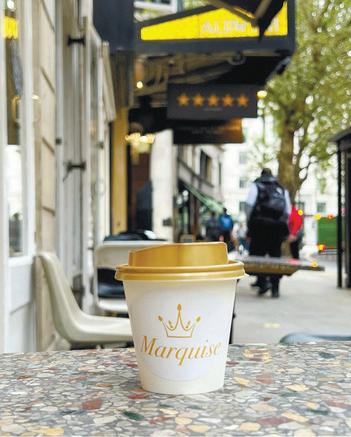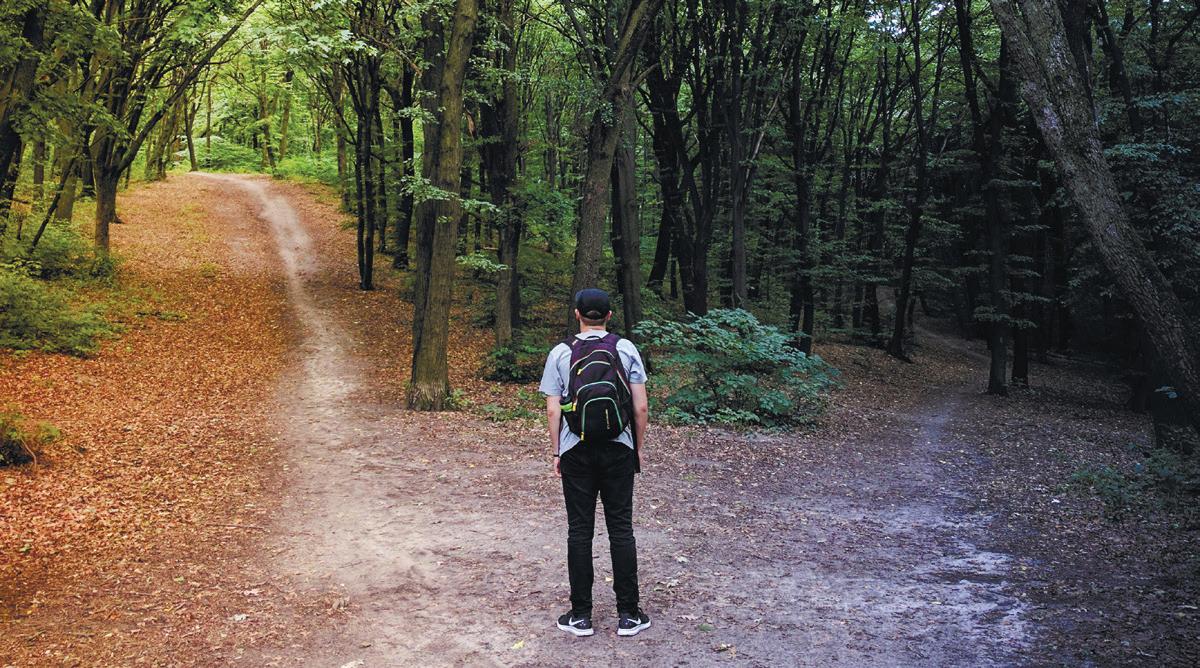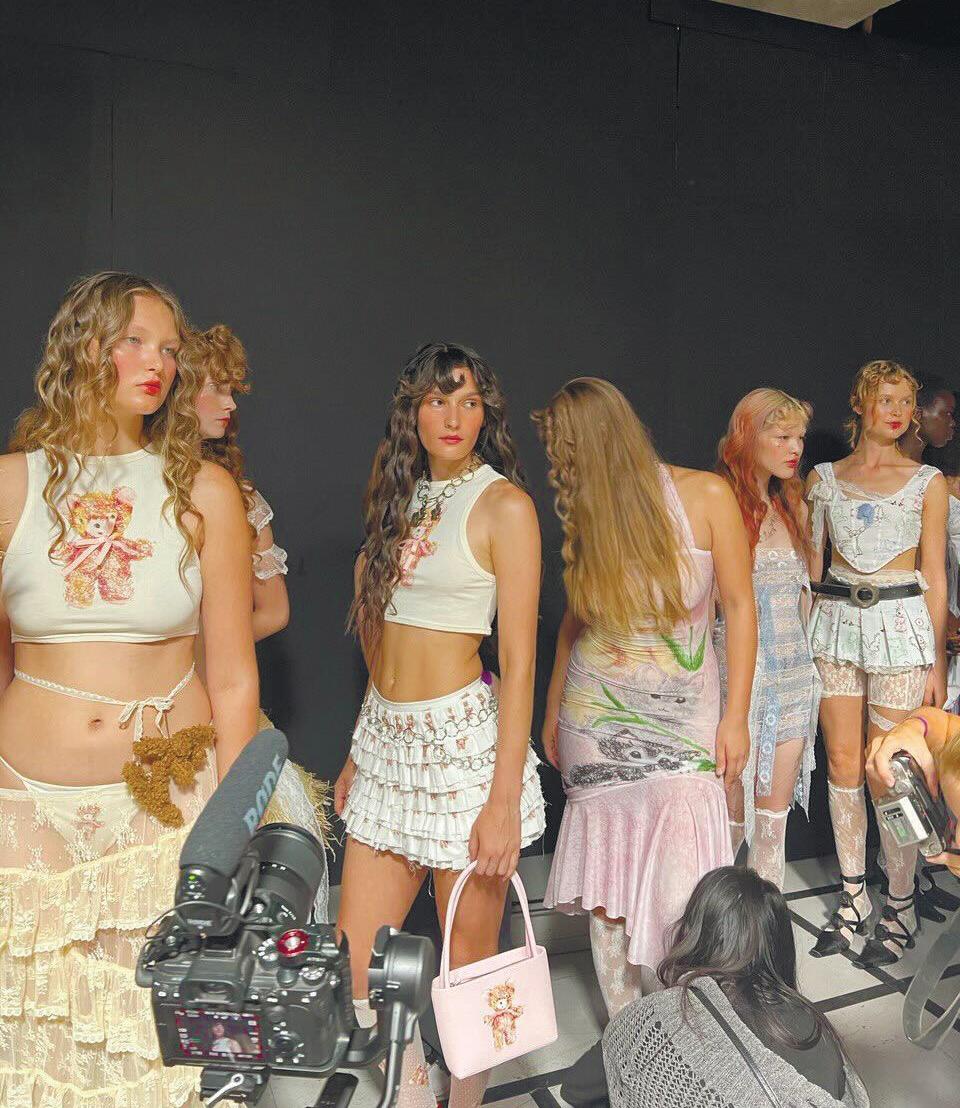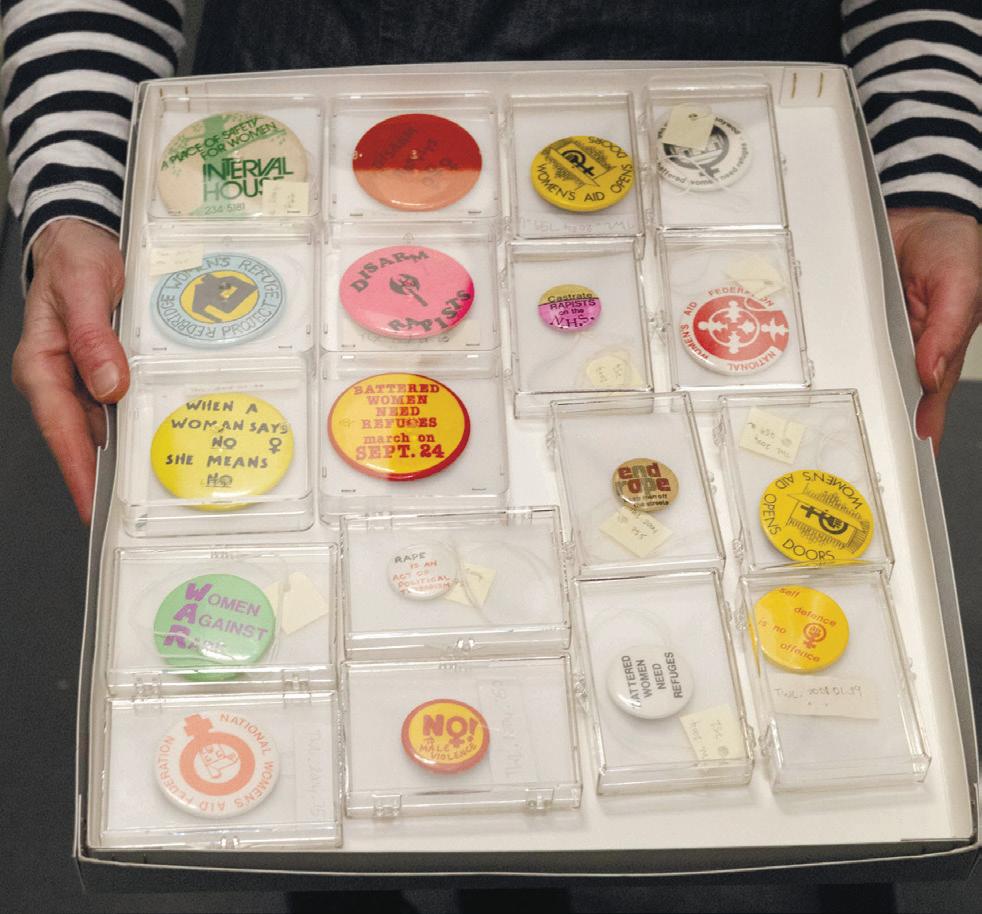

Making sense of LSE since 1949
Women silenced across ranks: LSE’s mishandled sexual misconduct investigation against professor
content warning: sexual assault, sexual harassment
by Amadea Hofmann, Features Editor
LSE Law Department under fire for hosting event with Israeli historian Benny Morris Page
read on page 8
FEATURES
The lost changemakers at LSE: Students navigating the search for meaningful careers
Page 10
OPINION
On Gaza, institutional neutrality, and the adversarial nature of British academia
4 NEWS Issue 933 | WT Week 8 Read The Beaver. Online.
Page 12
Photographed by Ben Chen and Angus Timmons
Executive Editor

Alan Nemirovski executive.beaver@lsesu.org

Managing Editor Eugenia Brotons Batista managing.beaver@lsesu.org

Flipside Editor Sana Agarwal editor.flipside@lsesu.org

Frontside Editor Vanessa Huang editor.beaver@lsesu.org

Multimedia Editor Claire Yubin Oh multimedia.beaver@lsesu.org
News Editors
Iraz Akkus
Chenoa Colaco
Features Editors
Liza Chernobay
Amadea Hofmann
Opinion Editors
Honour Astill
Kieran Hurwood
Part B Editors
Emma Do
Julietta Gramigni
Review Editors
Christina Jiang
Sheila Mutua
Social Editors
Rhea Jethwa
Kaviesh Kinger
Sports Editors
Robert Khandzhyan
Matt Sudlow







Beaver Sound Editors
Kate Banner
Laila Gauhar
Illustrations Editors
Francesca Corno
Mithalina Taib
Photography Editors
Ben Chen
Angus Timmons
Videography Editors



Valerie Schwane Torres
Rebecca Stanton
Website Editors
Hila Davies
Christine van Voorst
Social Media Editors
Emma Gallagher
Do something, please!
Alan Nemirovski
Executive Editor
Welcome to our first — and likely only — 32-page issue of the year. This one's going to be a big one, obviously, but not just because of the amount of pages to flip through, but also because of the stories we are sharing in this edition.
Puzzles, continued






Some of the topics we're covering this time around are part of larger, ongoing issues and conversations that we hope we can help advance. However, we hope the stories we're covering in this, and every other, edition of the paper, not only inform you but inspire you to do something about it — no matter which story it is (even if it's something from Flipside, lol).
Action doesn't necessarily mean showing up to a protest tomorrow, or organising your own campaign. Instead, I think it simply means not being a passive observer of the

world around you. Whether that be taking time to research a topic (for the love of all that is good not Instagram infographics though), engaging in meaninful discussions with those around you, or actually engaging in campaigns, protests, and such — every little bit counts. And every little bit, eventually, becomes a meaningful addition to your life, and the lives of those around you.
So as you read some of the stories we're publishing, and the coverage we share going forward, I just ask that you do something, please. Because the last thing we want is for the paper to be tossed away and everything to stay the exact same as it was before. We'll be doing our part, even once we have left this paper. But any change requires us to work together, hence this slightly long-winded plea.


 Eugenia Brotons Batista Managing Editor
Eugenia Brotons Batista Managing Editor
Dear readers, I hope you enjoyed the Valentine's Day Crossword last issue (see solutions on the right). This week, I leave you with another one of my favourite types of puzzles: Sudoku. Enjoy!


Fay Qian









Issue 933 | WT Week 8 www.thebeaverlse.co.uk 2
Meet the team
1) CORPORATE 2) POLITICS AND INTERNATIONAL RELATIONS 3) MEDIA, COMMUNICATIONS AND THE CREATIVE INDUSTRY W O M E N I N S P I R E D W L T ’ S A N N U A L F L A G S H I P C O N F E R E N C E FEMALE SUCCESS IN A CHANGING LANDSCAPE SCAN ME! 9 March, 2024 9:00 AM - 5:15 PM O U R P A N E L S
Copyright © 2024 SudokuTodo | For personal or classroom use only. Play online or make your own free printable sudoku at SudokuTodo.com Fill in the puzzle so that every row across, every column down and every 9 by 9 box contains the numbers 1 to 9.
3 9 4 7 5 2 4 7 5 3 4 2 2 9 8 6 7 4 8 7 4 1 2 9 4 8 1 8 5 9 3 4 1
Medium Puzzle #1
Specialty coffees and teas with delicious bites including vegan options a friendly atmosphere in the heart of London’s prominent colleges



@themarquiselondon






DISCOUNT ALERT: 10% discount if you show up with this newspaper from
6th March until 20th March 2024
Each newspaper entitles a one-time discount only.
3
LSE Law Department under fire for hosting Israeli historian Benny Morris
Iraz Akkus Chenoa Colaco News Editors
Staff and students at LSE have voiced opposition to the LSE Law Department’s decision to host Benny Morris on campus as an event speaker. This is following a series of events covering conversation panels and podcasts on the conflic in Palestine and its development.
The event was hosted on 4 March, with the venue being released only on the day, for security reasons.
Students can also access the event online.
Morris has been labelled as a “radical” Israeli historian, known for his controversial views towards Palestinians, Arabs, and Muslims, with comments such as “there are times in history that justify
ethnic cleansing” and “[i]f he [Ben-Gurion] had carried out a full expulsion – rather than a partial one – he would have stabilized the State of Israel for generations.”
He has also made several xenophobic and Islamophobic comments, arguing that “human life doesn’t have the same value” in Islam, and Arab societies have “no moral inhibitions”. Morris states that he is a “Cosmic Pessimist”, on the belief that Palestinians will never support a two-state solution following the second Intifada from 2000.
Education and Welfare Officer
Sarah Onifade expressed disappointment at his invitation, stating that Morris’s history of “inflammatory rhetoric” has “no place in our academic institution - or any inclusive society” and will harm the LSE community.
Among Morris’s critics are
many well-accredited professors and professionals, including Norman Finkelstein, an American political scientist, who engaged in a direct debate with Morris on the Israel-Palestine conflict.
Dean of LSE Law School
Professor David Kershaw responded to the criticism in an email sent to Law students on 23 February, re-asserting his pride that the department has “convened a balanced discussion on the current political conflict”. He used a personal anecdote of his discussions with the Prime Minister of Jordan, who encouraged him to “create a space for everyone from all sides to speak”. He also encouraged students to contact him about any further concerns they may have.
A student who reached out to Kershaw states that his response “did not engage with any of the specific remarks I highlighted, which identified
hateful justifications of various racist atrocities made by Morris. Instead it claimed that the place of universities is to host ‘all sides’, rather than to take a side, and that hosting speakers ‘does not imply in any way that we institutionally agree with that speaker’”.
The LSESU Palestine Society launched an open letter against the event and held a rally in protest on 28 February outside the LSE library.
A representative from the LSESU Palestine Society commented, “The Law School’s invitation of Morris despite pushback, including from LSE’s own Risk Spotting group, is extremely concerning. Morris’ unapologetic statements about Palestinians, Arabs, and Muslims clearly constitute hate speech, and by platforming him, the Law School and the LSE as a whole are failing in their duty of care towards students and staff vulnerable
to racism and Islamophobia. This is especially harmful given today’s context of genocide against Palestinians in Gaza, and rising anti-Palestinian, Islamophobic, and racist violence in Europe and the US. We have expanded on these points in our open letter, which you can read online.”
An LSE spokesperson said: “Free speech and freedom of expression underpin everything we do at LSE. Students, staff and visitors are strongly encouraged to discuss and debate the most pressing issues around the world.
“LSE has clear policies in place to ensure the facilitation of debates and enable all members of our community to refute ideas lawfully, and to protect individual’s rights to freedom of expression within the law. This is formalised in our Code of Practice on Free Speech and in our Ethics Code.”
LSESU Grimshaw Club hosts Dr Husam Zomlot, UK’s Palestinian ambassador
Iraz Akkus News Editor
On 13 February LSESU
Grimshaw Club hosted the UK’s Palestinian Mission Ambassador, Dr Husam Zomlot. The event was attended by LSE students and staff; it featured opening remarks by the Ambassador, followed by a Q&A session moderated by Professor Myria Georgiou.
Dr Zomlot, a Palestinian economist, diplomat, and academic, shared his expertise, drawing from his academic background at Birzeit University and LSE. Dr Zomlot also previously worked as an economist with the Office of the United Nations Special Co-
ordinator for the Middle East Peace Process (UNSCO).
Zomlot was appointed Ambassador of the Palestinian Mission to the UK in 2018, after previously heading the Palestinian Liberation Organisation (PLO) to the United States before the initiative was halted by the Trump administration.
During the event, discussions ranged from the history of the Israel-Palestine conflict to the unfolding of the recent war. After being asked what steps to take going forward, Zomlot commented that “the last day of occupation is the first day of peace”.
Regarding international reactions to the International Court of Justice’s (ICJ) recently
announced verdict, Dr Zomlot emphasised the need to uphold the law without politicisation, “the law belongs to all of us”.
A student who attended described the event as “important not only for LSE’s Palestinian community but also for encouraging more academic involvement in showing what self-defence ethically is and when it is actually justified.”
A representative of The Beaver who attended the event commented on the respectful and engaged atmosphere of the crowds, with a long standing ovation to mark the end of the event.

News Editors Iraz Akkus Chenoa Colaco news.beaver@lsesu.org NEWS 4
Home Office denies visa for Palestinian refugee PhD candidate at LSE
Chenoa Colaco News Editor
The UK Home Office has rejected Palestinian refugee Amena El-Ashkar’s student visa for an LSE PhD programme on the grounds that it would “harm the public interest” of the UK. El-Ashkar had previously lived in London and holds a fully-funded four-year scholarship for the course.
El-Ashkar told The Beaver that she applied for her PhD student visa twice. The first application received no response after a four to six month wait period. The second application was initially accepted, but three weeks later El Ashkar received a letter saying it was denied.
Legal proceedings revealed that former home secretary Suella Braverman had personally certified her visa rejection; this lack of disclosure has been deemed ”unlawful” by a judge in the Upper Tribunal for Immigration and Asylum cases.
Home Secretary James Cleverly has since said he is willing to start a fresh application for El-Ashkar.
Having previously completed her Master’s degree in Israeli Studies at SOAS from 20192020, El-Ashkar was granted the Chevening scholarship, a fully funded scholarship for “outstanding emerging leaders”. El Ashkar was the first Palestinian to pass the interview stage in 25 years, being one of three students to receive the scholarship in the year she applied.
Despite assurances from LSE regarding her visa, El-Ashkar encountered unexpected challenges, highlighting the School’s limited understanding of refugee experiences. With “the number of Palestinians who’ve made it to this level [being] very few, if any, in the first place,” El-Ashkar underscored the importance of awareness and support from the LSE community, expressing frustration over systemic barriers faced by Palestinian refugees.
El-Ashkar’s initial visa acceptance meant that she began her PhD programme online for a few months, with the intention of continuing in-person pending visa confirmation. She praised LSE professors and staff for being “welcoming”, with the International Rela-
tions department in particular being “amazing and very very supportive.” Certain professors would regularly contact and check up on her during her visa application process. LSE has also reserved her space on the course in case the rejection is rescinded, which El-Ashkar commends.
At LSE, El-Ashkar’s research would have focused on the civilian experience of the Palestinian-Israeli conflict.
El-Ashkar, born and raised in a Palestinian refugee camp in Lebanon, opted to enter the UK through her education rather than as an asylum seeker, fearing the plight of being a “double refugee”. “I am already a stateless refugee. And I did not want to become a double refugee,” she says.
El-Ashkar says that Palestinians are “treated as a security threat”; this has impacted her academic pursuits and mental wellbeing. Acknowledging the reluctance many have towards engaging in discussions about Palestine, she urges continued support and awareness from the LSE community. “I don’t want people to forget me,” she says.
An LSE spokesperson said: “LSE provides dedicated support and guidance for refugees, forced migrants and displaced students who are looking to study at the School and throughout their time with us. In addition, students
can access specialist advisers within the Student Advice and Engagement Team who work to support applicants. Students and applicants can contact the team using the enquiry form on How to get specialist visa advice at LSE.

Off-peak train and Tube fares offered all day on Fridays
Salome von Stolzmann
Contributing Writer
Starting March 2024, Transport for London will start a three-month trial offering off-peak train and Tube fares all day on Fridays. This trial, requested by London Mayor Sadiq Khan, aims to increase passenger numbers and boost London’s economy. Tube usage on Fridays stands at about 73 percent of pre-pandemic levels, still affected by people working from home.
With the mayoral election approaching in May, critics view the trial as a political move in part of the election promise to reduce cost of living. Sadiq
Khan has re-asserted his intention to increase footfall for shops, cafés, and cultural venues amidst the cost-of-living crisis.
For London university students commuting on Fridays, this trial comes as a welcome relief. Many London students benefit from discounted fares through their 16-25 Railcard,
saving one-third on off-peak Tube fares. With peak fares in London typically applying during rush hours, an LSE student commuting from Zone 3 for an early morning lecture on Friday will pay £1.95 instead of £3 if they have a Railcard linked to their Oyster.
A postgraduate student commuting from Windsor states:
“Fridays going completely off-peak is going to make me worry less about attending my Friday lectures.”
Postgraduate student Ella*, who previously worked from home on Fridays, agrees, stating that “the new off-peak Friday fare will be a game changer. I am looking forward to spending my Fridays in the
city as I did prior to the pandemic and staying out after work, making the most of the city I live in.”
The off-peak trial will allow LSE students to save money on their Friday commute to campus from the beginning of March until the end of May.

NEWS 5
LSE community protests against fossil fuel and arms investments
Janset An Staff Writer
Illustrated by Francesca Corno
Agroup of concerned students launched a campaign in February calling on LSE to divest funding from arms and fossil fuels industries as well as companies that violate international law in its investment portfolios. Research from the students suggests that LSE is not commiting to its Environmental, Social, and Governance (ESG) policies, despite assurances from the School.
LSE’s funds come from various sources including grants, donations, and capital portfolios totalling an approximate £500 million. Unlike other universities, LSE states that it does not directly invest in individual companies to generate an estimated annual return of 4.5%; instead, they manage their investment portfolios through external fund managers.
According to their ESG policy, LSE commits to managing its portfolios in a way that “strengthens human rights” and contributes to the “global effort to reduce carbon emis-
sions” while working towards achieving its own Net Zero by 2030 aim.
The policy also ensures “indiscriminate arms manufacture” is not funded as LSE is a signatory of the United Nations supported Principles for Responsible Investment. However, a representative of the campaign has told The Beaver that “LSE does not live up to its stated promises.”
Students analysed LSE’s investment portfolio by matching its investments in index funds with publicly available data on the composition of these funds. This uncovered the proportion of LSE investments parked in companies that violate ESG policy.
The group’s research shows that LSE has at least £4.4 million invested in fossil fuels and £1.7 million in arms. An additional £1.6 million were found to be invested in four companies on the UN list of companies deemed to be complicit in illegal settlement activities in the West Bank such as Booking.com.
The School’s primary fund manager, the Royal Bank of Canada, handles 60% of its in-
vestment portfolios. This bank was found to be the largest fossil fuel financier globally in 2022. JP Morgan, another significant fund manager, is known to invest in nuclear weapons, cluster munitions and landmines.
Campaigners have distributed informational pamphlets on campus with a survey to attract student interest. They state that their goal is to prompt students to express dissatisfaction in the National Student Survey, which could affect LSE’s ranking. They hope this will exert pressure on LSE to divest since a low ranking could have negative effects on the School’s reputation. This would affect donations, number of applications, and its ability to raise tuition fees.
Unless LSE is granted a gold, silver or bronze award by the TEF, a rank assessed through the National Student Survey, it cannot charge the maximum of £9,250 for its tuition fees and would instead be capped at £9,000, further threatening their revenue.
An LSE spokesperson said: “For many years, the School has rightly committed not to invest directly or- as far as

possible- indirectly invest in companies engaged in tobacco manufacture, indiscriminate arms manufacture, or companies significantly engaged in the extraction of thermal coal and tar sands. Since the introduction of the previous Socially Responsible Investment policy in 2015 we have seen a significant drop- over 85 per cent - in exposure to investments in these areas.
“In 2022, with the aid of student input and consultation, LSE adopted a renewed Environmental, Social and Governance Policy (ESG) to guide our investment practices. “This policy includes the School divesting from all fossil
LSE urges banks to sever ties with fossil fuel industry
Vanessa Huang Frontside Editor
LSE, as part of a coalition of UK universities, has threatened to withdraw funding from banks and asset managers unless they cease financing of fossil fuels and expedite net-zero initiatives.
The 21 universities, managing over £5 billion collectively and led by the University of Cambridge, are asking banks to provide environmentally friendly deposit accounts and money market funds.
The universities in the coalition are looking for products and services that follow targets set out by the International Energy Agency’s 2050 net-zero
scenario, which would keep the global temperature rise within 1.5°C. Interested financial institutions were required to disclose the details of their fossil fuel funding by the end of February.
This move comes as universities face mounting pressure to end their associations with the fossil fuel industry through divestment. The University of Edinburgh, also in the coalition, completed its full divestment from fossil fuels in 2021. LSE has significantly slashed its exposure to high-risk industries, including thermal coal, tar sands, tobacco manufacture, and controversial weapons, reducing its exposure to 0.5% in 2022/23.
However, LSE has stopped short
of full divestment, citing its reliance on mutual funds, which means that “direct action by LSE to exclude investment in specific companies is not possible.”
In response to rising concerns
over sustainability, Barclays, Europe’s top financier of fossil fuels from 2016 to 2022, risked the termination of its more than 200-year-old relationship with Cambridge unless it ended fossil fuel financing. Barclays has since pledged to end
fuel companies that fail to align with Paris Climate Targets, or similar international pledges based on the Transition Pathway Initiatives’ ratings. This means seeking to eliminate -on direct investments- and greatly reduce exposure- on indirect investments- to the worst polluting fossil fuels, not just coal and tar sands.
“We are committed to strengthening our approach to responsible investment in line with the ESG. In addition, we have recently joined other universities and organisations to encourage the banking sector to develop more sustainable options.”
fossil fuel financing alongside industry peers HSBC and Société Générale, although banks continue to maintain ties to the fossil fuel industry through other means such as corporate loans and bond markets.

6 NEWS
LSESU Animals Society welcomes therapy dogs on campus
Saira Afzal Staff Writer
Photographed by Himani
Iyer
On Monday 19 February, the LSESU Animals Society held their weekly ‘Dogs on Campus’ event, hosting three dogs for a visit in the LSESU Saw Swee Hock building. Hermès, a blue merle rough collie, Rosie, a greyhound, and Kolby, a golden retriever, visited LSE campus as volunteers from the national charity Pets As Therapy.
LSE students enjoyed a session feeding the dogs and playing games like fetch. All visiting dogs were certified therapy dogs, who regularly take part in sessions to promote stress relief and mental wellbeing. The LSESU Animals Society has hosted three sessions with therapy dogs to date.
LSESU Animals Society President, Himani Iyer, stated the society hopes such sessions provide students with a respite from the stress and strains of university studies. She added that the sessions can be an

opportunity to foster new connections with peers, although they equally welcome those preferring a moment of quiet enjoyment.
Jonathan Fingerhut, a Pets As Therapy volunteer and Rosie’s owner, echoed similar sentiments on the value of pet therapy. He described spending time with pets as “meditative” and highlighted the “non-judgmental” nature of dogs, who can even offer an alternative to forms of traditional therapy which may be intimidating. As an LSE alumnus himself, Fingerhut understood the unique challenges students
face and how interacting with dogs can alleviate stress.
For one attendee, the session provided a rare opportunity to experience pet companionship. She stated her asthma led to her parents discouraging pet ownership at home, limiting her exposure to pet therapy. The session with LSESU Animals Society offered her a valuable mental health retreat for a few hours and sparked a desire to own dogs herself.
The LSESU Animals Society plans to organise future events, including puppy yoga and a visit to a cat café.

LSE secures £2 million in funding for sustainability renovation
Chenoa Colaco News Editor
LSE has been granted £2,697,890 through the Public Services Decarbonisation Scheme, a project spearheaded by the government’s Energy Security and Net Zero department. The grant will be used to phase-out fossil-fuel-based heating in the LSE Library and Connaught House.
Global professional services company Turner & Townsend was commissioned to assess LSE’s direct carbon emissions, recommending that LSE install air source heat pumps and enhance existing solar panels and LED lighting circuits in both buildings.
This project is part of LSE’s overarching goal to achieve net-zero direct carbon emissions by 2030; phasing out fossil fuel heating is Scope 1 of the three-scope plan.
LSE’s interim President and Vice Chancellor Professor Eric Neumayer said: “We are thrilled to have received the PSDS funding grant. Our buildings and their operations are crucial to maintaining our student experience and to addressing our climate impact. This funding will help LSE accelerate on the journey towards our net zero goals.”
Students expressed approval at LSE’s work towards net-zero, but some voiced concerns about construction works and the School’s investment practices.
A current MSc student, who also completed their undergraduate degree at LSE, said: “After being at LSE for 4 years, I’ve experienced some campus construction and how noisy and inconvenient it can be. The library is a huge part of campus, and knowing LSE, these works will be dragged out as long as possible.”
Another student believes that these changes do not distract from LSE’s indirect investments in oil and gas companies: “LSE is putting a sticking plaster over its complicity; it thinks that using taxpayer money for some new infrastructure and dedicating a bit of its own money to sustainable grants can make up for its unethical investments in oil companies and the fossil fuel industry.”
An LSE spokesperson said: “LSE’s plans to develop the Lionel Robbins Building and Connaught House are instrumental in phasing out fossil-fuel-based heating and advancing our goal of ‘reaching net-zero and reducing our direct environmental impact’ as affirmed in the School’s Sustainability Strategic Plan.
“Students’ education and learning is of utmost impor-
tance and, to this end, we have extended the programme of work to take account of study, learning and exam periods. Any potential disruption will be kept to a minimum as far as possible. In addition, the LSE Estates team will work with relevant stakeholders, who may be impacted by the works, to understand their concerns and keep them updated on progress and upcoming works.”

NEWS 7
FEATURES
Women silenced across ranks: LSE’s mishandled sexual misconduct investigation into professor
In September 2023, Taylor Sherman, a professor at the London School of Economics and Political Science, resigned after working at the university for over ten years. In her three-page resignation letter, Sherman attributed her departure to LSE’s systemic mishandling of a sexual misconduct case.
The LSE investigation commenced following four formal complaints of sexual assault and harassment made against an LSE faculty member. By July 2022, a total of five formal complaints and nine informal allegations against the accused individual were brought to the attention of LSE. Multiple accounts were submitted by the individual’s former students.
Following the investigation, an LSE disciplinary panel did not uphold the allegations and the accused individual returned to teach at the School.
In an interview with The Beaver, Sherman said, “The complaint system [at LSE] seems to be set up to protect the faculty, and does not just let these abuses happen, but discriminates against the people who complain.
“The very top levels of the school were completely unwilling to address discrimination, victimisation and abuses of power.”
exchanges where colleagues’ proposals to improve EDI [Equity, Diversity, and Inclusion] goals were treated with derision and contempt.” She requested to transfer because she “did not find LSE conducive to [her] research and well-being.”
Many of the women who made formal complaints declined to comment because they did not wish to relive their experiences. Several people also expressed concern that commenting on the department’s culture could lead to victimisation from within LSE or legal action by the accused individual.
The eight women who spoke to The Beaver are current and former staff members and students predominantly from the department. Collectively, their accounts detail an investigation and aftermath that did not adequately protect those affected, citing the perceived failings of the appointed investigator, the disciplinary panel, and the people at the highest levels of LSE leadership.
A “deeply flawed process”
When Leila* began her PhD under the supervision of the accused individual, multiple women shared their experiences and warned her of his pattern of behaviour. Feeling unsafe and concerned, Leila opted to change supervisors.
“The very top levels of the school were completely unwilling to address discrimination, victimisation and abuses of power.”
The departmental culture experienced by two postgraduate fellows caused them to permanently leave LSE in early 2023. In a statement obtained by The Beaver, one of them described the atmosphere in the department as “extremely toxic, evidenced in meetings and
physical contact.
Ultimately, four women, including Jane, submitted formal complaints against the individual between March and
May 2021 through LSE’s Report It Stop It portal. The process would span a year before the disciplinary hearing concluded; although notably, the women involved did not receive a formal notification signalling its end. Jane described it as a “deeply flawed process from start to finish.”
When the LSE investigation was launched in October 2021, the accused individual was suspended with pay. LSE also assured the women that the investigation would be overseen by a professor with expertise in handling matters of sexual misconduct. These steps were seen as “encouraging” by Leila.
However, it did not take long for the first cracks in the process to appear.
Two months after the individual’s suspension, the affected women contacted LSE to express their concern and confusion with the individual partaking in public events while maintaining his affiliation with LSE, which LSE had assured them he could not do while suspended. Only several months later, when similar grievances were raised to LSE again, did the university inform them that the individual was in fact under a “partial suspension.”
The accused individual also allegedly breached his suspension by attempting to interact with Jane and Leila on social media.

best practices,” according to Leila. For instance, Jane described the quality of the minutes from the investigator’s interviews as “shockingly poor.” The women who were interviewed recorded the meetings and cross-checked the minutes against their recordings. They identified discrepancies that omitted “vital points” and contained factual errors leading to “constant contention” with Human Resources. In response to these concerns, the investigator chose to save two versions of the minutes, rather than one mutually agreed-upon record.
Moreover, the investigator allegedly failed to interview a number of witnesses. This includes those that the women had identified as having knowledge of previous unreported allegations against the accused individual, as well as the people who could substantiate the women’s accounts.
The affected women submitted a list of 13 alleged incidents of sexual misconduct involving the accused individual, four of which were the submitted formal complaints. The women anonymised the list and informed the investigator that it would be possible to establish contact if they were willing to investigate the additional information sensitively.
as potential gross misconduct, which would potentially result in the accused individual’s dismissal.
However, a letter sent by LSE’s legal representation instructed them to “refer to Part III, Section 13, Bye-law 3” of the Academic Annex, which outlines the procedure for a “matter [that] is more serious but falls short of constituting possible good cause for dismissal.” The maximum sanction under this procedure is a written warning that would be disregarded after two years, subject to satisfactory conduct and performance.
In October 2022, the affected women heard rumours that the accused individual was being reinstated in his position. It was only after the women’s barrister, whom they had crowd-funded by incurring a cost exceeding £10,000, requested clarification from LSE that the women learned that the investigator had recommended two of the four complaints to the disciplinary panel. They were then notified that the panel did not uphold any of the allegations and that the accused individual would indeed be returning to LSE.
Jane*, a PhD student, recalled an encounter with the accused individual at a weekend-long trip for staff and students in the department. The individual allegedly showed her his hotel room and attempted to kiss her while engaging in unwelcome
Issues also emerged within the investigation itself. The appointed investigator was an LSE statistics professor who lacked “appropriate training” and “didn’t know how to deal with the matter in line with
LSE also “never really provided [the women involved] with any clear terms of how this investigation was going to be conducted,” according to Leila. Initially, the affected women were told that LSE would investigate the matter
Jane did not receive an outcome letter outlining her options until 6 February 2024, 16 months after the disciplinary procedure had concluded and five days after The Beaver sent LSE a request for comment.
According to Leila, it was a “very difficult and frustrating” process for the affected women.
Features Editors Liza Chernobay Amadea Hofmann features.beaver@lsesu.org
8
“You want to trust your institution to take these sorts of things seriously. I think it was just such a difficult reality to comprehend,” Leila added. The ordeal resulted in her having to take six months of medical leave for anxiety, stress, and depression.
The aftermath
Once the investigation concluded, the accused individual sent a message to other LSE staff members criticising the actions taken against him. In an email obtained by The Beaver, the individual condemned the “bullying campaign of rumours that has been waged against [him]” and invited the “opportunity to discuss the toxic and hostile work environment [in order to] stop rumours.”
In September 2023, following the investigation and an unrelated leave of absence, the accused individual returned to LSE. According to Sherman, he “started victimising the women involved” by gathering “several allies [who] shouted at junior colleagues in meetings [targeting] anybody who was not white, all the junior women, anybody who had a reputation for supporting EDI initiatives of any kind.”
Before the investigation, four female faculty members in the department gathered to
revamp a first-year module, including Sherman and a woman who was an advisor to one of the complainants. Current and former members of staff recall a Zoom meeting in November 2022, where the new syllabus was one of the agenda items. Only two of the four women who participated in revising the syllabus were present at the meeting.
Despite the accused individual not being on the initial email invitation with the Zoom link, he joined the meeting. As Maya*, a formal postdoctoral fellow, described, attacks by the accused individual were “couched in intellectual disagreements,” but the subtext was clearly about airing “bitterness” regarding the investigation. The “people who had the power to stop him [the heads of the department that were present] didn’t, and his supporters jumped on the bandwagon,” Maya said. “It was deeply unprofessional and uncalled for.”
The discussion ended with the approval for the revised syllabus being withdrawn and being subjected to further revision.
Following this meeting, Maya recalled thinking, “I can’t survive in this department [...] I felt incredibly unsafe as a young woman of colour [...] nobody was there to protect

me.” She left LSE shortly after.
As all of this was unfolding over six months, Sherman filed two formal complaints to Minouche Shafik, the Director of LSE, arguing that the accused individual’s conduct was “victimisation and discrimination,” as defined by the Equality Act 2010. After seven months of Sherman’s follow-ups, Shafik responded, suggesting “informal conciliatory measures” and that mediation should be explored and exhausted to minimise “complaints or misunderstandings between staff,” in accordance with Part VI of the Academic Annex. A spokesperson for LSE added that Shafik acknowledged this was already ongoing, “which she hoped would reassure … the matters raised were being looked at and considered fully.”
The internal mediation was undertaken by two members of LSE senior staff. Sherman described their efforts as “utterly disastrous,” because “they didn’t do anything to stop the abusive behaviour.”
The two members allegedly instructed staff concerned about the department’s culture not to respond “if somebody makes an offensive statement or discriminatory statement in a meeting,” according to Sherman. In addition, Sherman was “personally told to stop making formal complaints about violations of the Equality Act.”
Discussions with formal mediation to create a departmental code of conduct began in May 2023. However “the formal mediation process doesn’t seem designed to address the core issues,” Sherman said. In In November 2023, an open letter written and signed by 27 current and former PhD students raised concerns about the departmental culture, including worries about the state
of the department’s commitment to equality, diversity and inclusion.
“It’s just been really, really difficult to see LSE’s protection of one individual who has sexually harassed all these women and students,” Leila said. “LSE has really failed all of us in so many different ways.”
The long road ahead
Women’s professional and personal lives have been derailed. Accomplished women, who joined LSE to attain doctorates and teach students, stated that they have been traumatised and silenced by the very institution that was supposed to protect them.
The issue of sexual misconduct seems to extend beyond one department. Johanna Thoma claimed that several women in a different LSE department have alleged that they were subjected to sexual misconduct by a senior staff member but have not felt comfortable formally reporting their allegations to LSE.
LSE, in a statement, said: “LSE is committed to a working and learning environment where people can achieve their full potential free of all types of harassment. We take any reports of harassment extremely seriously and any member of the LSE community who has experienced or witnessed this is encouraged to get in touch with a trained Safe Contact for information and support, use dedicated online portal Report it Stop it or report via other means.
“The School recently set up a group to review its approach to sexual harassment and sexual violence, to further develop and maintain a supportive culture. This process included wide-ranging discussions with experts from within our community,
Support for survivors of sexual assault in and out of LSE
You can speak to a Safe Contact, a member of LSE staff trained in offering confidential ‘signposting’ for staff and students who have, or a currently experiencing any form of bullying, harassment, or sexual violence,
A full list of internal resources is available from the LSESU: https://bit.ly/lsesupport
the Students’ Union, as well as external specialists. LSE subsequently put in place a range of actions to strengthen our processes around and support our community further. This includes specific training for a diverse group of staff, including senior leadership, to build understanding of sexual misconduct and violence in a university setting and to make sure any investigations, adjudication and sanctioning are trauma-informed.
“Alongside this, in close working with the Students’ Union, LSE has employed a specialist member of staff with expertise in sexual harassment and violence, to provide a consistent point of contact from disclosure through to any other university or criminal processes.”
As it stands, the accused individual continues to teach at LSE. The affected women have resorted to a final recourse by filing an appeal with the Office of the Independent Adjudicator (OIA), the regulator for the higher education sector in England. In emails obtained by The Beaver, the OIA noted LSE had repeatedly not responded to the OIA’s information requests despite the extended deadline, which was labelled a “compliance issue.” The women are still awaiting a decision.
Still, as Maya observed, many still fear retribution for speaking out. She claimed that due to his position and connections in academia, he “can destroy your career without it ever being traced back to him.” And yet, many women have been courageous enough to speak out about their experiences in this article, refusing to be silenced.
*Names have been changed to preserve anonymity.
Read the full version online.
The Havens: support for people who have been raped or sexually assaulted in the past 12 months. Phone: 020 3299 6900
National Rape Crisis Helpline: 0808 500 2222 ; www.rapecrisis.org.uk
Survivors UK: support for male identified victims of sexual violence
Galop: provides support for LGBT+ people who experienced sexual assault or violence
FEATURES 9
The lost changemakers: LSE students navigating dreams, ambitions, and realities
Matthew Chiu Contributing Writer
As the School’s administration consistently emphasises, LSE students are changemakers. Some want to start the next fintech unicorn. Others hope to research the inner motivations of human behaviour in academia. Still others aspire to fight poverty at the United Nations. The winds of fate do not lead us astray: we determine our fates, live out our “main character” lives, and create our destinies. Starting from this corner of Houghton Street, where we learn to understand the causes of things, we want to improve the world using that knowledge.
But our ambitions to serve the world with our talents occasionally hit a brick wall. We may be rejected after multiple interviews and tests. We may miss deadlines. Even worse, we may not even hit that brick wall, not because we fall short, but because the world blocks us from our ambitions.
There are two forms of pressure at LSE. The first is the mutual feeling, known universally to LSE students – I call it “the panic.” Most students are intimately familiar with the social pressure to rush into conventionally safe and well-regarded career paths such as banking.
“LSE enforces a very pre-professional atmosphere,” says Siddharth Kataria, President of the LSESU Economics Society, and the fear of missing out on the smooth banking path when friends around you are landing spring weeks is
significant. Especially when the media are consistently blasting about the tyranny of inflation or tyouth unemployment, this can induce extreme stress. In this light, “don’t worry too much in your first year” – one of the bland mottos lining Houghton Street – seems akin to a meaningless hodge-podge. When everyone around you is rushing to put themselves out there, joining the crowd feels like “fulfilling your moral imperative that you came here for a reason,” Siddharth says.
The second form of pressure, however, is more rueful. These are pressures from the world that block ambitious students from achieving their dreams. These pressures include UK and US visa requirements, which stipulate a minimum salary for staying in the UK. These pressures include the necessity to provide for family or children. These pressures include the prohibitive costs of further education or simply living in a world-class city like London. I spoke to an ambitious third-year international student studying Politics and International Relations, who reported difficulty navigating the London job market for opportunities outside of banking. Think tanks were impossible as most do not sponsor visas. Equally, the costs of a further degree in the UK are staggering: LSE’s MSc Economics programme, for instance, costs £33,480 for home students. Thus, many students who were promised a better life by coming to university feel awkwardly trapped.

Facing these external constraints, what should ambitious and altruistic LSE students do?
LSE’s Effective Altruism Society recently organised an event examining the link between ambition and altruism. Speaking at this event were Celine Mano, an ex-Goldman Sachs trader turned development economist, Peter Wallich, ex-Boston Consulting Group consultant currently working on AI policy in the UK government, and Lorenzo Fong Ponce, operations analyst at Amazon and a Giving What We Can pledger. Beyond their illustrious CVs, the speakers shared a desire to funnel their ambition towards improving the world. The speakers emphasised career flexibility, mentioning that one’s first choice does not define the rest of their life. They encouraged students to develop their leadership skills.
According to Eugene Shcherbinin, President of the LSESU Effective Altruism Society and chair of the event, one of the most insightful nuggets of career wisdom was to “maintain and guard your values through your career”. The importance of cultivating tolerance, care, and virtue is often unsaid but should never be forgotten. In the era of COVID-19 and ChatGPT, we are in a constantly changing world. These challenging times underscore the importance of introspecting and evaluating your relationship with wider society. Your values shape you and your decisions, and maintaining humanity against the tides will drive you forward and press you to seize the moment to change the world when it comes.
LSE students can feel like they’re on top of the world after securing the coveted entrance ticket into the prestigious internship. But in allowing yourself to celebrate, exhorted Siddharth, remembers that this is just the begin-
ning. “Stay humble and you’ll do great.”
Another piece of advice that Eugene found insightful was to “broaden your knowledge so that you can pivot into high(er)-impact roles”. More knowledge, especially across different fields, inherently
The fellows echoed this sentiment: “I was able to learn a lot about impact,” said Justin Cheng, a first-year participant. Mihika Chechi, another firstyear student, agreed, saying that she participated in “really interesting and important discussions”. Both felt they gained increased clarity into
“These are pressures from the world that block ambitious students from achieving their dreams.”
helps open up opportunities. Eugene recalled an acquaintance who completed a PhD and then worked at a startup, and another young professional who pivoted from venture capital to AI safety. Careers are flexible and long: LSE academics often bridge into journalism, fiction-writing, or government advisory. What’s important is to tap into the spirit of exploration and to find that community or cause that makes you a better person.
While opportunities to broaden one’s scope and range may seem rare at LSE, a closer look reveals the existence of many paths. Whether learning about important world issues, Afro-Caribbean literature, or how to box, opportunities abound – one just has to be aware of them.
This past term, I organised a fellowship programme for LSE students interested in Effective Altruism, a research area and community investigating and implementing the best ways to help others. What I’ve learnt from organising the fellowship is the many ways in which one can do good. Altruism isn’t limited to joining an NGO or the Civil Service: everyone on the fellowship brought different experiences and ambitions. Some are interested in conventional career paths and join the fellowship to learn about donating effectively, while others hope to learn about ways of improving NGO governance.
the many pathways for doing good.
At LSE, I’m grateful to meet people who inspire me with their ambition, curiosity, humility, and kindness. Some may be succeeding in their careers and pursuing lofty dreams. Others may realise that there are some dreams that they can’t pursue immediately. But the core character trait is to feel the full force of the moral obligation to help fellow citizens and never stop questioning what you can do.
For aspiring changemakers who may not be able to follow their preferred path today or are afraid of being driven astray, don’t forget to be driven by your humanity and curiosity. Everyone has a role to play, and even if your role today isn’t perfect or not the one that best matches your ambitions, keep chugging along with the realisation that what you are doing matters.
It starts here at LSE, where one can work towards developing an insatiable and unquenchable curiosity about ideas and individuals, meeting people who inspire, exploring the diverse societies on offer, and participating in the causes that are fighting for a better world here on campus. Let our humanity guide us as we chug along to save the world. ing words of Dylan Thomas: “Rage, rage against the dying of the light.”
10 FEATURES
Is LSE’s Wellbeing Service worth the wait?
Jessica-May Cox Contributing Writer
Illustrated by Francesca Corno
Content warning: brief mentions of suicidal ideation, discussion of mental health.
Mental wellbeing is an increasingly important topic of discussion, with seven times more university students reporting a diagnosed condition compared to ten years prior. University students are a particularly vulnerable group, going through rapid changes and often being away from family and familiar support networks for the first time. In addition, the recent pandemic and cost of living crisis has increased loneliness and financial pres sures, further contributing to lower levels of happiness.
When I struggled to adapt to new circumstances in my first year, I decided to try my luck with the LSE Student Wellbe ing Service. I have had a lot of experience with mental well being services in the past –throughout secondary school, Child and Adolescent Mental Health Services, and the NHS in general – but I have not been fortunate enough to call them positive experiences.
This meant that I did not start this investigation free of bias –in fact, my expectations were low. After signing up to write this article, I was approached by Lucas, a second-year Man agement student. He lament ed that, after citing suicidal thoughts in his self-referral form, he was told to wait three weeks for an appointment.
the number of practitioners, meaning appointments are not readily available, but this does not necessarily devalue the quality of the counselling and service itself.
Counselling was at the centre of my personal experience, and I was surprised to find that everyone’s first six sessions are free. This means that an undergraduate student is allocated a total of eighteen free sessions over three academic years. Considering that this is a non-government service, this system will serve most students well.
While going through the services, I kept a note of the timeline of events and what each stage entailed. Just one day after submitting the application form, I received an email
to research and make sense of them all by myself. This is especially the case in troubling times, where the Herculean feat of finding out what is best for me has stopped me at the first hurdle.
We agreed that counselling may benefit me, so my advisor sent me a link for self-referral, and I was told the next day that I have an appointment in two weeks. I was satisfied, as my goal was not immediate care – although I can understand why the wait may be frustrating. My aim was to learn what aids I have at my disposal and to establish a swift and practical plan that I may act upon if I am discouraged in my academic work later in the year.
“When I confessed that I did not know what to do, she excitedly exclaimed, ‘That’s why I’m here!’”
Nevertheless, I believe that the people who already work at the Wellbeing Service are passionate about their jobs. I had a total of two sessions with my counsellor, and she instantly made me feel comfortable and helped me establish a sense of agency. When I confessed that I did not know what to do, she excitedly exclaimed, “That’s why I’m here!”
Her wholesome dedication was reinvigorating compared to the many cold and awk
My counsellor and I decided to save my free sessions in case I needed them later in the year, but I could easily resume by emailing the counsellor directly instead of starting back at square one, which would definitely help with reducing wait times. It also put me at ease regarding anything that might occur in the future.
Overall, I waited for nearly four weeks before my first counselling appointment –ten days for the consultation appointment, and another fourteen days for counselling. This might be demoralising for those who require urgent care, but once you have had your initial appointment, I absolutely believe you have a strong support network for your academic life.

While Lucas’s account understandably paints the LSE Student Wellbeing Service in a negative light, it is important to understand that they are not a replacement for urgent care response. On the website, they provide several links and numbers for around-the-clock support and encourage contacting 999 if anyone is in immediate danger. Unfortunately, the high demand greatly exceeds
with details for an initial consultation appointment. Although it would have been in ten days, I was surprised with how quickly they booked me in; in fact, the ten day period was similar to the waiting times I have experienced in the past, if not slightly better.
The first appointment consisted mostly of signposting, which is when a practitioner provides a list of organisations that may be able to help further. Personally, I found this helpful. While it is possible to approach these services directly, I have experienced firsthand how it can be tiring
tember and October. Considering there are only three full-time equivalent staff, it is impressive that they are able to keep up, respond, and book appointments so quickly.
However, the lack of sufficient staff is the main flaw which stands out in the service. Matt, a third-year Data Science student who expressed that the service has “supported [him] in times of crisis”, agreed that it would benefit from more practitioners, as “availability of appointments are sometimes in short supply.”
hours with LSE Life, as well as to call my GP and resume my case with the Primary Care Service during the Zoom appointment. All the while, she consistently praised me for being proactive and commended me for using the service before I found myself in a bad spot. After admitting that I didn’t think my situation was “too serious”, she assured me that the services were equally supportive for all cases. Even if you are trying to find ways to support yourself further down the line, they are there for you
Ultimately, my experience with the LSE Student Wellbeing Service was swift and short, but it left a lasting and positive impression on me. I was pleasantly surprised by the enthusiasm of my counsellor and the wide scope of the service, putting my previous experiences to shame. The wait times may be unsatisfactory in pressing situations, but that is even more of a reason not to wait. Our university has an extremely useful tool readily available to all students; I regret not utilising it sooner.
If you are contemplating using the services even if it’s just for peace of mind, I strongly encourage you to do so.
FEATURES 11
On Gaza, institutional neutrality and adversarial British academia
Anonymous LSE Faculty Member
Ivy League universities in the US have been heavily scrutinised over the past months for their handling of the events of October 7, 2023, Israel’s response to the events, and campus responses from pro-Palestinian groups; it ultimately led to the resignation of the President of the University of Pennsylvania and was a contributing factor to the resignation of the President of Harvard University. Meanwhile, across the Atlantic, there has been no substantive scrutiny and there have been no resignations at British universities for the same reasons. This poses what initially appears to be the right question: what are British universities doing right, that their American counterparts are struggling with?
But I think this ignores a key difference, and it is important, particularly in the context of the current conflict in the Middle East. Over the past few years, British universities have increasingly taken a position of ‘institutional neutrality,’ which broadly means that the university itself will not take a position on anything (not sides in a war, and several have withdrawn from high-profile organisations designed to sup port minority groups on cam pus, such as Stonewall).
The argument that has been made in support of this approach is a combination of the following: “who is the uni versity anyway? An institution is not a real person”. If an insti tution is its staff, it is likely that on any issue the opinions of staff would diverge so sig nificantly that it would
not be possible to put forward a consensus view. At best, such an expressed view would represent a majority of staff, and can a majority view ever accurately represent an institution’s view? British universities have made clear that, in this environment of institutional neutrality, the only thing they will protect is academic freedom of speech and this is presented as being unapologetically clear and without problem.
There are a couple of challenges with this. First, in the context of the current conflict in the Middle East, antisemitic as well as Islamophobic attacks have increased since October 7. Generally, in British universities, Professors may specialise in disciplines such as international law and human rights, but there are no equivalents who teach and research the laws and customs of Judaism, Islam, other religions, and of Israel and other states in the Middle East. This means any debate or exchange of ideas, in relation to the current conflict in the Middle East, is occurring between a member of faculty in their professional capacity and a staff member or student in their personal capacity. Due to the rise in antisemitism and Islamophobia, for the staff member or student who is engaging in
such an exchange feels like it puts one at risk. In my experience, it is very difficult to have such exchanges without accidentally ‘outing’ your religious views. I backed down and out of a conversation when I got close to this line because I was worried about potential repercussions, even though I suspect my colleague could guess the basis of my ideas. This reality seems to be overlooked at the moment, but it is important because it makes it extremely difficult to have a frank exchange of ideas.
At this time, some faculties are encouraging staff and students to engage in discussions relating to the current conflict in the Middle East. This is healthy as it is likely to promote greater understanding. However, in my experience, because my religious beliefs are involved, discussions take bandwidth. The days I feel up for engaging do not always align with the opportunities to do so, like events organised to promote discussion of significant developments.
However, in pursuing institutional neutrality, British universities seem to be wanting us to do something different - to be active participants in a debate - and, in my experience, this makes the expectation of those whose religious beliefs are involved, who are a minority on campus in this particular conflict, very high.

If we do not engage, in my experience, our viewpoint is unrepresented.
The second problem is that, when exchanges do happen, they tend to be adversarial (i.e. each person defends
a different position). Such an approach can be perceived to be confrontational: it may prompt some to withdraw and others to become defensive and entrenched in their views. This approach may harden minds, rather than open them, at a time when there is already division and the issues, history, and solutions are complex.
One of the challenges of the modern world is that social media has democratised opinions. This removes the need, and perhaps the norm, for opinions to be fully informed, and this – perhaps coupled with academics’ desire to build
to find a way to fix this, what would potential suggestions be? What suggestions address the concerns of both sides?
This approach is collaborative and contributes to the broader benefit of society because it has the potential to provide nuanced and interdisciplinary solutions to match the complexity of the nuanced and interdisciplinary problems that the world is currently facing. As an example relating to the current conflict in the Middle East, some countries have been involved in extensive discussions and negotiations to find sufficient agreement

their individual reputations – has encouraged academic exchanges to become more of an exercise of pitting divergent views against one another with no real resolution and possibly upsetting the academics involved. My argument is that academia needs to do more. Rather than presenting the other person with a position and trying to persuade them that it is the correct one, even without the benefit of full evidence or information, and then either being victorious in success or ignoring them if they continue to disagree, it would be beneficial for society for the exchange to be framed differently. Key questions on both sides should be – what does this view or conclusion I have drawn based on the facts I think are correct ignore about the whole context? What can you (the other academic or person in the exchange) see that I can’t? If we were going
ity that they will not. However, that is a far more valuable exercise than publishing blog posts, opinion pieces, and articles that only alienate current parties involved, escalate, and exacerbate the conflict, potentially driving a bigger conceptual divide between the ‘sides’ (and I write this recognising the irony of writing an article to set out this argument).
If we are sincere in our belief as academics that universities can contribute to the betterment of society, then maybe we need to reflect more on our real potential to do this and work more collaboratively. Maybe then, and only then, can British universities claim any sort of moral high ground over their American counterparts in relation to cultivating genuine freedom of speech on campuses, and especially the type that contributes to the betterment of society.
“In pursuing institutional neutrality, British universities seem to be wanting us to [...] be active participants in a debate.”
Opinion Editors Honour Astill Kieran Hurwood opinion.beaver@lsesu.org OPINION 12
On the possibility of power through protest
Cameron Baillie Staff Writer
Acertain conception, all-too prevalent in Western liberal democracies, understands power as unilateral and homogenous. This deeply corrupting and corrosive notion is the same monolithic conception of power employed by despotic generals and maddened supreme leaders, theocratic ayatollahs and tyrannical party chairmen. It is the notion that power is something to be possessed only by governments, or their particular heads, and that this is the way things should be. This view was also recently expressed by UK’s Shadow Foreign Secretary David Lammy.
While giving a speech on the future foreign policy plans of a Labour government at the FEPS-Fabian Society Conference on Saturday 20 January, Lammy was interrupted multiple times by disruptive pro-Palestinian protestors. He was visibly irritated by the ordeal, though he played it down. He began to express support for ‘sustainable ceasefire’ in Gaza, before laughing frustratedly as he was further interrupted by more activists, with jeers from the crowd accom panying their forced removal.
The affair prompted him to declare that he wants “change through power, not protest”, and reiterated this new slogan at least five times, rather mad ly. A fellow LSE student and friend of mine, who was pres ent at the confer ported him even saying publicly “I’m sick of pro test. I want power.” This zealous admission of apparent mega lomania (‘an un naturally strong wish for power and control’) is some what amusing, con juring in my mind imagery of some
Foucauldian cartoon villain like Emperor Palpatine.
But such a statement should not amuse. To come from a central figure in what was once the party of popular politics, completely deriding protest and ignoring its place in political change, is ignorant of both history and current affairs. Lammy didn’t acknowledge the root cause of why these people feel the need to protest: precisely because his party, the (probably) soon-tobe super-landslide-majority government, offers little more than our current government to address the ongoing massacre of Palestinians, despite clear, live-streamed and film-documented evidence of war-crimes committed by one of our ‘long-time allies’. Lammy is likely not a despot, but his unitary view of power to me appears corrupting, and offers a glimpse at much about our problematic common conceptions of politics.
Lammy’s statement was deeply irresponsible in multiple ways: firstly, in the literal sense that it absolves Lammy himself and those in elected positions of power of their responsibility. As such, it rescinds all perceived power those in govern
have much political power. His central self-positioning in an unprecedentedly authoritarian party, which expunges diversity of opinion (without appeal) and expels left-wing ideas contrary to Starmer’s line, will be his legacy. That’s how he’s decided to use his political power, rather than to bear with conviction the responsibilities bestowed upon him by election.
As the PLP slides further to the right in desperate pursuit of electoral victory, despite being unable to maintain a position on anything – from the landmark £28bn ‘green prosperity plan’ to the abolition of tuition fees to fairer taxes on tech companies – its leaders have shown themselves to be spineless and devoid of principle. Given this, it is hardly surprising that those with principles and compassion, above mere political salience, have turned out in their millions to stand in solidarity with the people of Palestine. It is all the more important to do so when governments refuse to take meaningful action against atrocities committed by the Netanyahu-Ben Gvir terror regime, and especially when the central opposition offers no difference. If they cannot
u-turns, it is unsurprising that Labour MPs are now targets of protest campaigns.
Lammy’s sentiment is also irresponsible given it comes at the worst time for protest rights in this country’s recent collective memory. Separate legislative measures enacted in the UK – the Police, Crime, Sentencing, and Courts Act in 2022 and 2023 Public Order Act revisions – have been condemned by the UN’s special rapporteur on environmental defenders, Michael Forst. At least 630 arrests were made for peaceful protest within a month last autumn in London alone, for the explicitly non-violent, valid, and time-honoured act of marching down a public road in collective protest, specifically at our government’s disastrous environmental policies. This figure was condemned by civil rights group Liberty, while Forst drew particular attention to the case of one protestor imprisoned for up to six months for peaceful demonstration. This precedent is gravely concerning for democratic ideals.
Protest is vilified by government and opposition alike, with Rishi Sunak recently de-
rights to climate justice to anti-colonial struggles in Palestine, both here in the UK and around the world. They also drastically misunderstand our social and political history: the instructive role played by regular people who refused to accept systemic ‘political realities’ and took political action of their own accord. It was only with the spirit of Chartism and later Suffragette campaigns that the British public finally won the right to vote for all.
How can we expect meaningful democracy when our collective agency is reduced to consultation every five years? How can we expect political leaders to provide sensible policy for us when they have vested interests in finance from careers in the City, second and third jobs, or our system promotes bare-faced cronyism and undemocratically selects lords and baronesses? They stoke culture wars and seek only political wins according to whatever zeitgeist or buzzword works today (nefariously vague ‘woke’ is currently popular). Who is voting for Labour, and not simply against maniacal Tories? There is no democratic system without democratic culture, one which truly offers agency to its people, something so sharply lacking in politics today.

ut trust in politics has plummeted, and requires drastic revamping: our issue is not with the principles of democracy, but rather with their applicaStarmer’s Labour is not remotely radical, and will not offer these necessary reforms. Until we are offered genuine space for political expression and true agency in politics, the disillusioned and disenfranchised will continue to manifest their power through protest. For now, under this corrupted system, the real potential for change remains with those acting outside of it.
OPINION 13
Having a ‘helper’
Honour Astill Opinion Editor
Igrew up in Singapore, a place – like Hong Kong and certain Gulf states – where employing domestic helpers is commonplace. These helpers, usually from the Philippines, Indonesia, or Myanmar, live in their employers’ homes and are tasked with cleaning, cooking, and childcare from Monday to Saturday. My family was no exception, and my parents employed domestic helpers with whom I built strong relationships throughout my childhood.
However, those many long, happy, days spent playing with my helper while my parents were at work were periodically punctuated by thoughts that inspired dread and terror in me. Why is it that [0000] is here taking care of me instead of her own young children? Why doesn’t [0000] get her own place to stay, more than one day a week off, and an independent life in Singapore? Why do other countries seem to get by just fine without helpers? Having forged a friendship with her, I was intimately acquainted with her life and acutely aware of how intractable the problems of distance she faced were.
No job in the world should inspire such a sinking feeling. It represents a perverse incentive to workers from low-income countries such as the Philippines. It deprives families of mothers, which remains a salient fact, given that the gendered division of labour (in which women are disproportionately tasked with childcare) is still alive and well in many Southeast Asian countries. Helpers often tasked with working strenuously, yet enjoy little independence or rest to show for it. In my opinion, rich countries who employ domestic helpers should not take advantage of their relative disadvantage to put women in vulnerable positions, simultaneously depriving them of their family, au-
tonomy, and own place to live.
In countries like Singapore and Hong Kong, a strong emphasis is placed on building the human capital of their citizens – given the paucity of natural resources or land for industry. By employing helpers to fulfil domestic labour tasks, workers can devote their time to profit-generating activities. Given that paying out what is a somewhat menial salary for Singaporean or Hong Kong residents represents a rather desirable amount for the average Filipina or Indonesian, the situation ends up apparently mutually beneficial for both parties. Remittances also represent a strong share of the Philippines’ economy given
“I can attest to having heard other classmates [...] insist ‘my helper likes sleeping on the floor!’ Routine exposure to people living in such conditions clearly desensitises many to inequality.”
how much money should be spent on sustaining their employee(s) are not particularly high. In one family I know, the helper has a self-contained house to herself that is twice my flat in size. However, for that one story, I have heard countless stories of maids enduring horrible conditions. My first helper decided to leave following a job offer in Hong Kong – who she was told was a French family – who later ended up being a Chinese couple who confiscated her
ee gets their own safe room, bed, three square meals a day, and a rest day – but helpers are reluctant to report violations of their rights for fear of angering their employer, who has the power to revoke their employment at any time, threatening their financial security, future work prospects, and their immigration status.
To be clear, this isn’t to say helpers are powerless or lack agency. Rather, in reality helper–employer relationships of-

the amount of foreign workers it exports. So it can be a way to brighten their futures: I have seen many helpers work for a few decades to send money back to their children and build a house before retiring. Hong Kong and especially Singapore are considered the par excellence destinations for helpers in terms of wages. The economic rationale is there. But what about the social and psychological rationale?
It’s an open secret among Singaporean foreigners that the manner in which helpers are treated is often highly variable. Almost any foreigner can afford to employ a helper, meaning the standards for
passport and made her work long hours. Denying her the ability to exit that work situation was the major problem; it deprived her financial and social freedom. Furthermore, I can attest to having heard other classmates in my high school literally insist ‘my helper likes sleeping on the floor!’ Routine exposure to people living in such conditions clearly desensitises many to inequality and mistreatment.
The conditions that domestic helpers enjoy is largely subject to their employer’s discretion. Singapore’s Employment of Foreign Manpower Act outlines that employers should ensure their employ-
countries’ standards. However, in those families in which helpers are scared, vulnerable, and subject to mistreatment, human rights are routinely violated behind closed doors.
According to Human Rights Watch, over a third of domestic helpers have reported abuse at the hands of their employer. Abuse of helpers is so commonplace that attention is seldom paid to it until a tragedy occurs. One particularly haunting incident was the murder of Piang Ngaih Don, a Burmese helper who was tortured and murdered by her Singaporean employer. For this, the perpetrator only received 30 years in prison. In the Gulf States, the situation is undoubtedly worse. Helpers are frequently traded on peer-to-peer vendor apps and it is acceptable for employers to withhold the employee’s passports. In Saudi Arabia, where protections are fewest,Philippine or Indonesian embassies are the only refuge for abused helpers, and its rooms are lined with sprawling bodies like a refugee camp.
ten end up looking nothing like what you might imagine. One family comes to mind in which I frequently see the helper boss the employer’s child around to run errands as if she were a third parent herself. Many helpers and their employer’s children end up building a relationship that is arguably stronger than that between the parent(s) and child.
In another family, I know a helper who one day decided to stop cleaning for a year. Both of these families came from the sort that pays a high salary and grants a lot of independence – perhaps in part from some sense of guilt over how clearly strange the live-in domestic helper system is by their home
On Sundays you might notice how Singapore’s landscape radically changes. On domestic helpers’ days off, some go to church, but many gather with their friends or have picnics. Not able to hang out at their employer’s house, or not really having anywhere else to go, helpers enjoy the parks and malls and for one day seem to enjoy the city like any other resident. In Hong Kong, on the other hand, helpers are relegated to often sitting in groups on the sidewalk on cardboard or plastic mats. The way that the city transforms on those languid Sundays is a startling reminder of the inequalities that are subjected to those who took care of the city’s children.
14 OPINION
Is the millionaire trophy wife lifestyle valid?
Suchita Thepkanjana Staff Writer
Worst things about being with a millionaire in Dubai is one of the video series featured on the instagram account @soudiofarabia. In case you were wondering, the worst things about being married to an Emirati millionaire include having too much good food to eat, always being driven in a Porsche (or is it a Ferrari? I wouldn’t know), and being given so many gifts you run out of storage (oh, the sheer horror).
When I ran into this video on my Reels feed, I assumed it was the work of a satirical account. I personally thought the sheer ludicrosity and shamelessness displayed here could only be part of some elaborate social critique of capitalism, consumerism, and traditional gender roles.
But a deeper look at her Instagram page revealed that I actually hadn’t come across clever social criticism, but rather, the culmination of the millionaire trophy wife subculture itself, a subculture in which the wives of wealthy men proudly and emphatically preach marrying rich as the ultimate goal for all of womankind.
Through miasmas of images of shopping sprees at Louis Vuitton, Michelin-starred restaurants, gold bracelets, and husbands thumbing through wads of cash, these self-proclaimed “status symbols” promote to their followers an alluring and glamorous life. Yet they fail to
acknowledge that the life of a trophy wife, no matter how enviably lavish, revolves around her husband. In this subculture, we witness not only the romanticization but the active promotion of the return to the archaic and, most of all, grossly unequal power dynamic between men and women.
Instagram and Tiktok accounts with followings ranging from 23K to over 300K have been promoting the same type of content: designer handbags, sports cars, and most importantly, immensely wealthy husbands. For example, the Instagram account @datetherich compiles viral videos teaching young women how to meet and charm rich men, such as dressing conservatively, acting like a “damsel in distress”, and being “lost” in the financial district of the city. Other videos propagate the idea that “a woman is a status symbol requiring genuine investment” from a rich man, that “rich men do not care about [your] job, money, or degrees”, and that instead, they just want “a beautiful trophy wife”.
Linda Andrade, who has 1.1 million Tiktok followers, has appeared on major publications such as The Daily Mail and The Post, proudly promoting her status as a “Dubai Housewife”. She, like many other trophy wives, married young (at the age of 19) to a much older, grossly rich man, and are now full-time wives and spenders of money, ironically, without their own source of income. Andrade notoriously spends about $2 million per
week, over $50,000 of which she calls “fun money”, and proclaims that she “[doesn’t] have any shame in flaunting a gold-digger aesthetic”.
John Stuart Mill famously claimed, in his essay On the Subjection of Women, that even after liberation, women would still actively choose to regress into the domestic spheres and assume their traditional roles as wives and status symbols.
At first, this sounds ridiculous. But isn’t that what’s actually happening in this social media trend? Is the huge
bags you want. This corner of the internet convinces women that education, employment, and financial independence are outdated, and that being a status symbol is somehow empowerment, not objectification.
Is milking your millionaire husband for designer goods really the new form of “female empowerment”?
Simply put, no. Being a rich trophy wife is not the ‘female empowerment’ it is portrayed to be. In reality, it is putting yourself at risk for financial abuse. Gift-giving and depending on
tech millionaire’s luxurious Emirati mansion in Dubai) is to discourage them from ever becoming self-sufficient, fully-mature adults in control of their own lives.
The young, unemployed wife of a billionaire (often an older man with more life experience) is at the financial and social mercy of her husband. The diamonds, manicures, and private jets fully-funded by a rich man look desirable, but as soon as that rich man’s sympathy and desire disappears, so too does the extravagant life and the identity that has been built on it.
“The diamonds, manicures, and private jets fully-funded by a rich man look desirable, but as soon as that rich man’s sympathy and desire disappears, so too does the extravagant life and the identity that has been built on it.”
popularity and glorification of being an unemployed, financially-dependent trophy wife an indication that women are regressing? Are we going right back to where we started?
This subculture essentially conveys to young women that the pinnacle of womanhood is, as mentioned in one of the posts, not getting a degree or a career, but being the pretty trophy wife of a millionaire husband. It is easy, they claim, to live lavishly if you forego university education, make yourself appealing to rich men, marry young, and let your wealthy husband buy you all the Dior and Chanel
each other are legitimate elements of a healthy romantic relationship, but to center your life around another person while abandoning any possibility to cultivate yourself becomes hazardous.
When your entire livelihood, identity, and sense of self are completely dependent on someone else’s finances, you are no different from a child whose life is sustained only by their parents’ money - as many international students at LSE will know.
To encourage women to go straight to a husband’s home (or, in this case, a fin-
To forego an education, a career, and an income of your own is to forego creating a safety net for your life – to have someone else pay for your entire life is to place it in their hands.
Regrettably and ironically, the trophy-wife status that so many women are aspiring to today is the same one women were fighting so hard to escape just a couple decades ago.


OPINION 15





























































A year in PULSE : Celebrating LSE’s creative community
Produced by Ines McCairley and Mithalina Taib, Edited by Claire Yubin Oh and Angus Timmons







Every individual is unapologetically unique, united under the music_ It’s a space where we are encouraged to unleash our true selves, transcending into a euphoric state of consciousness through dance_ In this series, I strive to capture this essence of the love and confidence which is created through music; there’s an undeniable power in the gritty, distorted beats that pulse through the air, uniting us in a shared moment of raw expression and profound connection_





















































SPORT

 EDITED BY ROBERT KHANDZHYAN AND MATT SUDLOW
EDITED BY ROBERT KHANDZHYAN AND MATT SUDLOW
From stadiums to screens: How social media is impacting sport
written by SKYE SLATCHER
I open TikTok to Carlos Sainz’s video set to ‘Pour It Up’ by Rihanna. I go across to X, and I’m greeted by Alpine F1 Team’s own meme about the backlash after their car launch. I move to Instagram, and find ESPN’s latest post about the NBA Celebrity All-Star game, not that I particularly care about it. I am constantly inundated with content about sports. Over five billion people use social media, growing yearly. With all of these posts out there all the time, what does it mean for fans like us, sportspeople, and creators themselves?
Social media is inescapable, so its involvement in the sports world will undoubtedly remain for a very, very long time. While there have been many discussions about the impact of social platforms on politics, teenagers, and general society, there have not been enough around ath letes, teams, and leagues. I spoke to two sports content creators with large TikTok followings, to get a better un derstanding of the environment: Irene (@irenexsu), a 22-year-old based in New Jersey with over 45k follow ers, and Cristina (@cristina.fastcars), a 28-year-old Canadian in Vancouver with nearly 90k followers.
In a field so heavily male-dominated, social me dia has had significant impacts on women. Irene shared the experiences of her friends receiving death threats on their accounts. It has given sex ism and misogyny a direct platform for targeting specific creators or athletes, with divisions being created in fanbases, for example, women in F1 being called ‘DTS fans’ (used to discredit new er fans who joined after watching the Drive to Survive Netflix series) and belittled for their interests. However, it has also allowed women to have a community to share opin ions and find support. These networks have encouraged more women to break into sports-based careers, strengthening the fight for equality in the industry, and for those like Irene who aren’t looking for a career in it, it has become an incredible way to make like-minded connections. Social media has been a key reason for the rise in popularity of women’s sports, from the Women’s Euros to the WNBA. These positives should not be under stated — the importance of these platforms in encouraging constructive change is powerful.
pions League match win by doing his ‘TikTok-famous’ dance with Micah Richards and Jamie Carragher. The latter shouted, “We are going to smash the internet. TikTok, here we come!” Sports personalities are so aware of the importance of media that it has changed how they interact with cameras. Athletes are aware that edits will be made, and the social content of many has become representative of this. There is something strange about hearing an athlete on a live saying ‘put this in an edit’ - it is almost dystopian.
In some ways, it has made these stars feel much more accessible and relatable. Through seeing two-time F1 world champion Alonso posting TikTok trends, Gasly being breathalysed (a now-deleted photo), or Lewandowski enjoying time with his children, social media has granted us an incredible insight into the lives of these people. They have moved away from being wholly unattainable, almost god-like figures, to being seen as having normal lives outside of their sporting excellence.
But, it is more difficult for an athlete to reach elite levels of their sport if they are not marketable. The Formula series are most clearly at risk of this. With only 20 seats in F1, the competition to get one is fierce. It would be naive to think that the sport has ever been meritocratic, but social media threatens to exacerbate the issue. Only those who have the sponsorships and media following would be able to get a seat, meaning those who are perhaps more talented but lack the follower count will never make it to the elite level. On the other hand, Cristina suggested that maybe the outcome will be the opposite - maybe those who do not have the family funds to secure sponsorships will be able to capitalise on social media. While we can hope for future trends to encourage inclusivity and dismantle the elitism in F1, the reality is that this seems unlikely.

There have been real changes for sportspeople too. Cristina and I agree that being a media personality is part of the game - no sportsperson can escape it. One example in football was Newcastle’s Dan Burn celebrating a Cham-
It has also meant that athletes’ actions have been under closer scrutiny than ever before. Bianca Bustamante, 18-year-old F1 Academy driver and McLaren Junior Academy member, recently found herself in a scandal after liking an ableist tweet about Lance Stroll. The backlash she received was immense, both to the tweet she liked and her apology post. People were relentless in attacking her for it, commenting on every one of her posts. Many took it as an opportunity to continue spewing misogyny. It was undoubtedly an awkward position for McLaren, having just signed her to their academy. But it was clearer than ever that sportspeople’s actions are watched under a microscope, and when a scandal arises, it is hard to shake off. As Cristina and Irene agreed, this was surely made worse by the fact that she is a woman. Other athletes like Nick Kyrgios have highlighted how useful social media has been in uncovering the uncomfortable reality of the views they hold. He recently expressed support for Andrew Tate — the post remains up on his X. It is unlikely these views would have been made so public without the platforms, which allow for backlash and ‘cancelling’ when needed.
So, has social media ruined sport? Well, ruined might be an exaggeration, but there have certainly been some negative consequences of the expansion of sports on social media. Its importance will not be dwindling any time soon, but perhaps the threats it poses can be mitigated. Stricter measures on sexist and misogynistic harassment and protections for young people against overly sexualised content must be enforced more effectively. As teams and leagues continue to get to grips with the rapidly changing trend cycles and behaviour of fans of social media platforms, we will continue to see developments in how it all impacts the sport. For now, I will go back to my endless scrolling, enjoying F1 drivers pretending to be their pets and my favourite creators’ views on the coming seasons.
SPORT
Superbowl LVIII recap
written by JOSETTE PEACOCK

Image via AP Photo
Super Bowl LVIII was a momentous occasion that showcased the Kansas City Chiefs and the San Francisco 49ers battling it out for the highest honour in America’s National Football League (NFL). The game delivered on all the tension and drama that fans have come to expect from the NFL championship and the biggest game of the year.
Played at Allegiant Stadium in Las Vegas, the game was the culmination of a season of hard-fought battles on the gridiron. The significance of high school sports was a central theme, highlighting how these institutions serve as a bedrock for nurturing talent and fostering camaraderie. In a symbolic gesture that bridged the amateur and professional worlds, the Lahainaluna by the Hawaiian Lahaina fires, was invited to participate in the coin toss.
The game kicked off with a tense first quarter where defences dominated, resulting in a 0-0 stalemate. The quarter was marked by a costly fumble by the 49ers’ running back Christian McCaffrey which halted an otherwise promising drive, and a stifling performance by the 49ers’ defence against the Chiefs’ quarterback Patrick Mahomes. As halftime approached, the 49ers managed to put up 10 points to the Chiefs’ 3. Despite the low score, the game was anything but dull, with turnovers creating tension and Harrison Butker’s field goal adding to the mix, with McCaffrey’s touchdown bringing the halftime score to its nail-biting conclusion.
During the long-awaited halftime show, Usher took to the stage in a dazzling performance that joined the high-energy competition of the first half with the intense anticipation of the second. The setlist was a curated journey through his hits, designed to resonate with the diverse Super Bowl audience. Surprise guests included Lil Jon, Alicia Keys, H.E.R, and Ludacris, who each brought a unique flair to the stage.
The third quarter brought more drama, ending with the Chiefs up 13-10 over the 49ers. The quarter was a rollercoaster, with a special teams mistake by the 49ers giving the Chiefs a golden opportunity that Mahomes capitalised on with a touchdown pass to Marquez Valdez-Scantling. In the fourth quarter, Kansas City tied the game with three seconds remaining, sending the game into overtime to determine the champion following yet another game-changing drive from Mahomes. In the heart of the action, Travis Kelce, the Chiefs’ tight end, once again proved to be an indispensable force.
The game’s climax came in overtime, with the Chiefs securing a 25-22 victory after a series of hectic possession exchanges. Mahomes displayed his trade mark clutch performance and connect ed with Mecole Hardman for the winning touchdown after the 49ers had settled for a three-point field goal. This resulted in the franchise’s fourth Super Bowl win — the third win

under the leadership of MVP Patrick Mahomes.
The iconic Super Bowl commercials have long been a hallmark of the event, transcending mere advertising to become a cultural phenomenon. With millions of eyes watching, companies pulled out all the stops, each seeking to etch their brand into the collective memory with creativity, humour, and pathos.
Super Bowl LVIII was a testament to the unpredictable nature of American football, where strategy, skill, and a bit of luck intertwine to create an unforgettable spectacle. It will go down in history as a game that exemplified the thrilling dynamics of the sport and the fun traditions that make the Super Bowl a unique cultural event.
Uncovering Fight Night #2
written by OONA DE CARVALHO
& photography by ANGUS TIMMONS
As Fight Night approaches next Wednesday, 13 March, I followed the fighters to their training session at the Oasis Sports Centre in Holborn to experience what goes on behind the scenes. Trying to grasp the appeal of getting punched in front of 1,200 people, I was curious about what drew these students to Fight Night, and how they are preparing for their big night in the ring.
This year, 13 sports clubs are represented, with fighters coming from a range of boxing levels. For some of the more seasoned fighters, like Loukas Manolopoulos, participating in Fight Night has been a long-standing aspiration, driven by a love for boxing. “I wanted to fight [last year] as well, but I wasn’t good enough”, he shares.
For many of the boxing newbies, the decision to join Fight Night was spontaneous, many were lured in by the free training programme and the chance to try out something new. Jeremy Ahearn, who had not heard about Fight Night before, decided to participate as it was “a great way to get in shape, have some fun, and represent the [lacrosse] team.”
As for Baby Cornish, she wanted to make the most of her time as a General Course student, and “prove that [she] could do athletic things and be a little scary”. Getting punched in the face for the first time, Baby recalls, was “very much a jarring thing…especially as a girl, because you don’t really grow up fighting anybody.”
The Beaver’s own Mithalina Taib shared how picking up boxing from scratch was at first intimidating. From learning the difference between jabs and crosses, to being asked whether she’s an orthodox or southpaw on the first day of training, it took a few initial sessions for her to learn the basics and ease into the flow of boxing. “There’s a lot of encouragement and all questions are welcome…It’s a good learning environment”, she says.
The fighters train up to 10 hours a week, with three mandatory sessions and two optional ones. As the Oasis training session unfolded, I watched the concentration and fervour in the fighters’ eyes as they delivered their punches. There was thrill and tension in the atmosphere. The anticipation of Fight Night loomed heavy over the room.
“You definitely feel the pressure because everyone is working so hard and you want to give the audience a good fight…You feel like you need to put in your everything in each session”, Mithalina comments.
Preparations extend beyond the official hours. All spars are recorded and sent to the fighters who meticulously dissect them with their team captain post-training. Loukas shares how seeing yourself progress through these videos “really makes you want to keep going.”

The captain of the blue team, Katherine Lo, expressed how she’s pleased with this year’s fighters and the work they have been putting in. “They’re all keen on improving”, she says.
Despite the intensity of the Fight Night training, there was a great sense of camaraderie. Friendly chatter filled the room before the session, and fist bumps and high-fives were exchanged between spars. Many expressed how they’ve enjoyed making new friends in the process. “[It’s] a bonding experience”, shares Evelina Rodriguez Moskalkova.
As encapsulated by the words of boxing coach Lewis Fattahi as he opened the training session, “We are not here to fight. We are here to learn. Learn the art and craft of movement”. These wise words from their coach will undoubtedly carry the fighters through their big night.
On that note, for the lucky ones who have scored tickets, it’s time to get your black ties ready, and enjoy a memorable night as the blue and red teams battle it out in the ring.








Women’s Basketball Surrey 1s 59 57 LSE 1s Women’s Volleyball Middlesex 3 2 LSE 2s Men’s Futsal QMUL 1s 9 4 LSE 1s Men’s Hockey UCL 2s 3 1 LSE 1s
Netball QMUL 2s 44 34 LSE 1s Women’s Rugby South Bank 40 12 LSE 1s SPORT
Women’s
SOCIAL
EDITED BY RHEA JETHWA AND KAVIESH KINGER
Revolutionary ramen
written by MIA LOBO & illustrated by NURISABELA AMIRA SHAH
It’s one AM. Sway has rocked your world and as you crawled home, one thing kept you going: ramen. Mcdonald’s chicken nuggets didn’t fill you up? Or do you want something sweet, spicy and salty, and also great for rehydration? You’ve come to the right place.
So here is that meal, slightly elevated, and terribly easy. Word of caution: if you are still drunk, do not use a knife. Please. This is my first article and I don’t want a lawsuit already.

Recipe
1. In a small saucepan, boil your egg. Set a timer for five minutes.
2. In a larger saucepan, add a drizzle of vegetable oil, and stir fry your garlic and ginger on a medium heat.
3. After two minutes (before garlic burns!), add in a stock cube, noodles, seasoning packet, and boiling water to cover.
4. Chop up your veggies into thin slices and add them in.
5. Once noodles are cooked (usually 4 minutes), turn off the heat.
6. Run your boiled egg under cold water and peel off the shell. Cut in half. It should be firm but have a runny centre if done right.
7. Now assemble, add everything to a bowl!
Optional: Top it off with some sauce/flavour of your choice, I use nam pla (fish sauce), soy sauce, and sesame oil. But don’t worry, it will be packed with flavour already.
There you have it. It’s delicate and light and full of flavour, in a more fresh and healthy way. That is the way to do it, people. I usually eat mine while watching Taskmaster or Come Dine with Me. Enjoy!
Solace in stout
written by ARCHAN ARULKUMARAN & illustrated by NURISABELA AMIRA SHAH

Lecturers droned, their words blurring into a monotonous hum. Readings remained untouched, the pages a jumble of meaningless symbols. Your senses scream for respite. Now, only one salvation remains: a pint of Guinness, its dark promise gleaming like a beacon, a cool oasis in the dreary aftermath of a misspent school day. The thought of venturing far is exhausting, so choosing the best on-campus spot is vital. The Three Tuns, George IV, or Ye Old White Horse – which will offer the solace you crave?
If it’s company you seek, The Three Tuns calls your name. It’s a place where conversations flow as easily as the stout, and you’re bound to bump into a friend or two. One Guinness may turn into a couple of five…the night has a way of stretching out deliciously when you’re in good company. But wait, what is this? A plastic pint glass? Outrageous! How does one split the G? And yes, it may have been a two-part pour, but how will I signal my devotion to the finest of stouts and rise above the pretenders with their inferior swill? This won’t do. This absolutely won’t do.
George IV is an interesting establishment. A two-part pour and a Guinness branded glass. Brilliant! But a big sign hangs from the ceiling: ‘LONDON SCHOOL OF ECONOMICS’. For just this one evening, I seek a brief escape in this pint, a temporary respite from those relentless demands. Yet, even here, within these pub walls, academia intrudes, mocking my attempts to forget.
There is one last hope, crammed in the middle of LSE. A refuge from the intensity of student life. The calm at the eye of the storm: Ye Old White Horse. Old Guinness adverts line the walls, ‘GUINNESS FOR STRENGTH’. It is dark inside – like the Guinness they pour. Creamy. Delicious. Perfect. The domed head lures me in. At last! The haven I seek. Yes, this pint is steeper, but to that I say: you cannot put a price on solace!
Who are these old men in Ye Old White Horse? Certainly not first years. Alumni? I don’t know, and honestly, I don’t care! They seem to exist in another dimension entirely, untouched by the urgency of essays and exams. Their weathered faces tell stories unknown to me, their hushed conversations hint at lives lived long and full. For now, my own story rests in the cool perfection of this pint, in the dark depths waiting to be explored.
An overdue thank you
written by IRAZ AKKUS & illustrated by NURISABELA AMIRA SHAH
Dear Jamon, Three Musks, Motorhomies, Arm Bands, Crownside girls, and my trusted confidants, this is for you <3.
For some time, I have been finding it incredibly hard to put into words what my female friends mean to me. I’ve spent hours interviewing my gal pals, showering them with millions of questions, reading books like Dolly Alderton’s ‘Everything I Know About Love’, articles on ‘sisterhood’ and how having a stable girl group is scientifically proven to elongate your lifespan. Creating a sort of mish-mash, Frankenstinian description to represent the phenomenon existing for those lucky enough to experience the love of girlfriends. In my eyes it was still wholly incomplete, and my hunt continued.
This phenomenon has been in the limelight for decades. Well-known books like ‘Women are from Venus, Men are from Mars’ have successfully led the way in setting out the difference of female companionship as figuratively, and arguably literally, being worlds apart from that of mens’ (no hate boys, I’m sure you got it good too). More discussions have also been sparked from our favourite shows and series, like Maeve and Amy (even thinking about their bus scene makes me tear up…oh and also ‘IT’S MY VAGINA’).
There has been increased focus on what many have dubbed, ‘platonic love’ or ‘platonic soulmates’, which until recently, I didn’t know was derived from (Plato)nic origins meaning “love between people could be so strong as to transcend physical attachments”. Though I agree there is no sexual characteristic behind my female friendships (sorry Grace), this labelling seems like a weak representation of what it feels like to be in a tightnight female friendship group. Doing so would feel like pouring an entire ocean into a shot glass.
Overtime, what started to set out my friendships with my women was their almost-psychic ability to anticipate: anticipating my moods, what I might need, how I might be doing or react felt like we all had a built-in anticipation-radar. There is a heart-throbbing intent to want to understand, to listen, and to relate. That’s why you almost always see women facing each other when they talk, with a slight lean in and the constant head nod in agreement; it has been ingrained in us since our primary school sleepovers, when sharing our secret crushes playing ‘kiss, marry, kill’ was the absolute centre of our universe. Our ‘emotional toolbox’ for instance, learning to be open and intimate, became the tricks of the trade of being a decent gal pal. Where boys would usually sit side-by-side doing some sort of activity-driven event, like watching football or rugby, on the whole, meeting my girlfriends rarely ever included having, or importantly needing, a background activity.
You just meet and talk freely, or yap infinitely if your name is Natasha Arora, and I can hand-on-heart say that is a level of support that has not been replicated by anyone else for me. It is definitely profoundly different to my friendships with my guy mates. Maybe it’s down to biology, or our shared experiences.
So, if X marks the spot then, X is wherever they are. X is the shoulder you cry on when you really thought it wouldn’t get any better, X is the phone calls late at night with the same exact issues I’ve had for the last decade, X is the bottle of much-needed wine shared, the champagne to celebrate all the small milestones, the rock bottom cigarette, the ugly confessions. Perhaps it’s a cliche and cringey trope, but being surrounded by my female friends has taught me much more about life. It just has. It has taught me gratitude, safety, companionship and love that is immeasurable when put into competition with that of my boy (space) friends.
Though this still seems like an open cold case, with infinite new leads, it does lead to one plausible conclusion. There is something rather ineffable and irreplaceable about the place female friendships hold. For me, they sit right in the centre of what makes my life utterly worth living. Being able to feel, truly and deeply without fear of never being able to drag myself out of it, be it crushing heartbreak or simply seriously wrong hair colours, there is no one else I could or want to do it with.
So my two pence is to go and thank your gal pals, go irritate them

with clingy acts of love because as much as I tell my flatmate Sheena to get off me, I secretly love her dwarfish hugs.
P.S I love you.
P.P.S I can’t believe I have written something for a boy before all of you.
P.P.P.S Flo, I knew this would make you cry.
London Fashion Week from the inside
written by SOPHIA-INES KLEIN
& photographed by AMELIE RACHELLE FOO
Fashion week, the distant, yet so deeply desired event to snag an invite to. With TikTok boosting the enchanting glamour of a career in fashion, more hopeful eyes have turned towards fashion week as a window into the industry. This past month, London Fashion Week (LFW) rolled in with shows popping up all over the city, and a catwalk of fashion professionals rushing between.

Post-LFW Autumn/Winter 2024, I spoke to two young people, Amelie and Sabrina, both in the midst of the action, to reveal what it is like working and attending shows. They offered a rather optimistic perspective of Fashion Week for hopefuls looking to get involved in coming seasons.
Amelie Rachelle Foo is a second-year Singaporean Fashion Marketing and Consumer Behaviour student at the London College of Fashion (LCF) in the University of the Arts London. She is currently interning with London-based luxury brand Huishan Zhang in PR, merchandising, and sales. This past February being her third season, she shares insight on the reality of working LFW.
Sabrina Ciauri, British-American Master’s student at LSE, gleefully told me that many people in the industry are more willing to help out than you would expect. She studies Global Master’s in Management at LSE, and having started sewing at six, she now leads her own brand, Via Ciauri, with her sister Mia. Her entrepreneurial experience first brought her into fashion, but she has also ventured into other sectors, including journalism, and sales.
With her multifaceted experience, and Amelie’s exposure to work backstage, they excitedly shared industry secrets that they have learnt along the way.
SK: How did you first get involved?
Having first attended a year ago, the prospect of being involved in LFW was a big push factor that led to Amelie pursuing a degree in fashion in London. She recounted how she emailed brands and PR agencies and received a few invites to attend shows during the Autumn/Winter 2023 season last year. This year, she wanted to be involved backstage and had the opportunity to help out at the Yuhan Wang and Ray Chu shows. Her current internship gave her the opportunity to see the whole pre-show process and “work on various fronts, from e-commerce shoots, to castings, to model fittings, to styl-

ing, and then the show day itself.”
SK: Can you walk me through a typical day in LFW?
Sabrina emphasised that the few shows she attends in a day does not compare to a typical day of professionals in high guestlist demand, like the editor-in-chief of a magazine, who would attend a minimum of 8 shows a day starting as early as 8:30 am. She outlined how the majority of attendees are press, influencers, celebrities, and buyers.
“I think there are a lot of things that people glamorise. Like the fact that people are in heels all day. I’ve seen so many people walk around the corner of the show, take the heels off, put them in a bag, and get on the tube! That’s most people during fashion week, because the reality is that a lot of people in press, and buyers go to 10, 15, or more shows in a day,” she revealed.
However, celebrities, whose LFW experience we more commonly see, go to fewer shows. She reflected on a time she saw Kelly Rutherford at the Mithridate show she attended, “As soon as she turns up, she’s got to put a lot of work into that appearance, into that outfit, wearing the brand as well.”
Sabrina interestingly told me that the PR teams are the big players in fashion week, being the ones who formulate guestlists, “They are really the ones making sure that the people who need to be there, are there.”
Amelie recounted a typical day working a show, emphasising the importance of being ready for any ad-hoc task given to you, sometimes involving carrying out final amendments to garments. “Usually, I’m assigned to dress a model with another intern. I have to get myself familiar with the looks, make sure I have all the accessories ready, be aware of the many intricate details like ribbons or even sock placement.”
SK: What aspect of the brand’s pre-show process was your favourite?
Through her internship experience, Amelie got to see final the work that leads up to the show, highlighting that stylist and model casting were here favourite processes.
“The styling was fun because it was very intimate, with just the Huishan Zhang team and interns involved. I really got to see the entire thought process behind a look. For each look, we tried many variations, just to make sure that each piece was styled perfectly. It’s a really long process, but it’s super interesting to see how it all comes together in the end.”
During the model casting, she realised the unexpected importance of choosing the perfect model to elevate each look. “With each outfit looking different on everyone. It’s really important to cast the right model, and style each look perfectly to enhance the look.”
SK: What makes LFW different from the other fashion weeks?
Sabrina described LFW as being the best fashion week for upcoming designers. “LFW has changed a lot over time. It used to be this space where we saw a lot of big luxury British designers, but the majority of those luxury players have migrated to Milan.”
“We have very much a focus on sustainability, although not as much as Copenhagen, but are different, edgy, and new.”
“It’s exciting because you get to see new textures and materials, it’s very innovative,” Sabrina said as she reflected on London’s unique fashion scene.
SK: What is the biggest lesson you’ve learnt at LFW?
“A lot of people coming in think that fashion is not a warm space, and I realised that that’s not a good way to approach it. There are so many people in the industry who want to help you,” said Sabrina as she emphasised the importance of learning from others.
She boasted her most effective tool of a coffee date, “Network, network! You might not want to do exactly what they do, but by getting a coffee with them, you’re going to start learning so much about the industry, and they might know someone who could help you.”
“It’s about being very genuine. The best way to approach it is as building friendships and relationships.”
SK: What is your advice for someone hoping to get involved?
Amelie and Sabrina both gave me tangible approaches to getting through the door. It was reassuring to hear that fashion industry hopefuls can gain access to opportunities in LFW, even at the start of their journey.
“Most entry-level roles in the fashion industry are volunteer-based, even as an intern my role is voluntary,” said Amelie on her current role at Huishan Zhang. “It’s all for your own experience and it’s very rewarding.”
Sabrina advised that most positions in fashion expect past experience, “If you don’t have any, I would take some courses. Central Saint Martins and LCF have great short courses. I did those and they really helped me learn about the industry.” Based on her own experience, she advised contacting professionals to be speakers at events, applying for internships, temping in sales, and pitching to fashion magazines as great first steps.
Amelie also highlighted maintaining a relationship with brands you work with, a step she took that gave her the opportunity to work their show for a second season. “It’s really about putting yourself out there and not being afraid!”
My conversations with Amelie and Sabrina illuminated so many aspects of LFW that I had no idea about. With LFW being over-glamorised, and it feeling so distant, it is nice to hear their optimism towards a career in fashion, and the warmth of the industry many in London have their sights set on.

SOCIAL
PART B
EDITED BY EMMA DO & JULIETTA GRAMIGNI
Feeling nihilistic and Flowers for Algernon
written by SALMA ABUELATTA & illustrated by CHIARA GUIGOU
Warning: This article contains spoilers for Flowers for Algernon.
I love to walk through Lincoln Inn Fields every morning and hear the grit of the cobblestone path with the mud between its cracks, clatter against my sneakers. To hear the tree branches swaying as birds hop be tween them, gleefully and carelessly chirping. In the middle of such a lively city and university, Lin coln’s Inn Fields is a microcosm of un disturbed reflection.
When I first arrived in London, I was as tonished by its vibrancy. My world was exponentially expanding and I was over whelmed with the sense that every cor ner was brimming with opportunity. I felt that same excitement and sense of opportunity in those around me. And just like the birds in the trees, everyone around me also seemed to be buzzing with life and personal ity. There I was in the middle of that cobblestone path, surrounded by beauty, life, and an oppor tunity to full-heartedly pursue my passions and cultivate myself.
So, why did I feel so empty?
To escape from that reality, I lost myself in a novel.
Flowers for Algernon by Daniel Keyes follows Charlie, a mentally disabled man, on his journey to acquire intel ligence through an experimental surgery, documented in a series of progress reports.
Before the surgery, Charlie looked at everyone around him in awe. He was aware of his inability to compre hend the extent of their worlds. He was aware that to others, he was merely an abnormality at the periphery of their lives.
Part of the beauty of storytelling is how the experiences of characters who are wholly different from you can so authentically capture your emotions. I can never know what it truly feels like to be mentally disabled in our fast-paced world, but I think we all understand what it means to feel as
though you are an abnormality, lying stagnant whilst others flourish. Whilst the possibilities of my world expanded, so did my sense of insufficiency when I realised how few of those possibilities I had explored.
When you begin to feel left behind, there tends to be two responses. You can either remain paralysed, encumbered by the futility of attempting to exert yourself and the impermanence of your achievements, or you can risk the difficulty of seizing for that sliver of a chance that you will successfully do the things you love.
Charlie chose the latter when he decided to pursue the surgery. And for a time, he succeeded. He rapidly developed and became a capable academic, generating original research. He states:
“I’m living at a peak of clarity and beauty I never knew existed.”
Yet, this success was temporary and his mind began to deteriorate rapidly to its former state. After cultivating himself so thoroughly, feeling peaks of joy that were previously out of his reach, Charlie lost the mind that had become the foundation of his identity.

Perhaps that was also the reason why I remained paralysed for months. I was simultaneously overwhelmed by the intensity of pursuing what I love, whilst also cognisant of the transitory nature of my efforts. Charlie’s ending is often read as a tragedy as he dedicated his entire being to something that was rapidly ripped away: himself. His regression was analogous to the death of the person he forged. Still, despite being aware this was a potential outcome of his surgery, Charlie pursued it anyway.
We may all eventually revert to dust and it is natural to grieve that loss. But maybe that is OK. Even if our efforts are ultimately futile, we can still be content with simply being driven by the hope that we come across rare moments of clarity and beauty. That moment when you are researching for a project and your mind pieces all the fragments together into a compelling idea. That moment when you are in the midst of your friends and you pause as you realise how loved you feel.
The hope is that we can immerse ourselves in what we love and that we share these things with others in meaningful ways. When I look around me at LSE, I see how others are overburdened by deadlines, but simultaneously overflowing with energy as they meet their friends or join in activities around campus that closely align with their passions. I see that. I see that effervescent hope.
We may not all reach such a peak, and even if we do, it certainly does not last. It may be near impossible to achieve all the goals that float around in our minds or find the ultimate answer to all our problems. But maybe the answer is in the attempt.
Every morning, I still choose to walk through Lincoln’s Inn Fields. I take that path slightly hopeful that I will see something gorgeous that day. Sometimes I am too distracted because I am late for class. But when I get to slow down and focus, I can see traces of different emerging greens returning to the trees as we transition from win-
PART B
Blackout poetry from our workshop hosted on 7 February 2024



Sinking
written & illustrated by JULIETTA GRAMIGNI
Sometimes you have to say
No
Or at least, Not be too eager to leave
And run when you are called And break from who you Were.
Stay a little longer
Do not change too quickly, Too suddenly
And disappear into Normality, letting
Disillusionment sink into you
So that in cold morning
You wake
To see through swollen eyes
The skin is entirely New and foreign.
When you taste
What it is to be free
It’s sharp and fills
The head
The mouth
Is a gulp of cutting, fresh air

And maybe you’re watching some Desperate run
Towards complete unknown,
A beginning breaking open.

Made in China
written
by
JESSICA-MAY COX
&
illustrated by MITHALINA TAIB
paper, the birth of civilisation gunpowder, a force to create countries a military base in 1962 - my mother forged in fire, she was made in china a graphics card, an apple iphone noodles for dinner, tea after your shower parts of your car, the seams in your bedsheets daily life; it was all made in china factory fires, assembly lines tears shed for a false father hush – don’t think ill of him a new era begins, one made in china left foot, right foot. march we shall not be bullied any longer. run away. thousands dead in ‘89 from a country painted red, she flees hurry, build a new life her daughter must grow big and strong While she’s growing weary, every day she works. she will not be broken. she was made in china she misses her home, but her daughter is grown to navigate the world, will she be alright? the child is strong just like her mother, she was made in china opium, the great leap forward a century of humiliation,
Deficient city in excess (City of excess)
written by CAMERON BAILLIE & photographed by JULIETTA GRAMIGNI

How many grand glass houses, In a city of oft-thrown stones?
Whose heart beats on, Through centuries gone, From empire, fossils, and bones?

How many lights burn brightly, Conscious of our plight, yet still nightly? Conscious as our plight grows nightly? None there to see, Such spent energy, From choices they make so lightly.
How many sighs of ‘good grief’, For those left to seek quick relief? From lives they made, Their career, their trade, Founded on such warped beliefs.
How many faces turn in, Just so as not quite to be seen? Post-work link-ups, And bagged pick-me-ups, Countless ciggies, drinks, and caffeine.
How many can find no home, Within this hard city’s great dome? Square feet ‘to let’, Yet none might they get, In this den of concrete and chrome.
How many minor concerns, As our planet crumbles and burns? What life we knew, As our fortune grew, I fear we may never return.
PART B
REVIEW
EDITED BY CHRISTINA JIANG AND SHEILA MUTUA
Avatar: The Last Airbender in
Concert
by KIERAN HURWOOD
 illustrated by MITHALINA TAIB
illustrated by MITHALINA TAIB
The classic cartoon Avatar: The Last Airbender, a fantasy series about ‘benders’ who can control the elements of the world around them (separate from the blue people), has recently been converted into a musical performance. Before beginning Avatar in Concert, a remarkable tour of the show’s original music by Jeremy Zuckerman, the conductor spoke about the importance of Avatar: The Last Airbender as a story about the main character’s personal struggle with his peaceable identity in the aftermath of a genocide against his people. This special production, drawing its musical influences predominantly from various East, Southeast and South Asian traditions, brought to the real world what had previous ly been confined to our televisions.

Particularly im pressive pieces included “The Last Agni Kai” and “The Beach”, where the use of lighting and integrated visuals brought firebending into the Royal Festival Hall. Other fan fa vourites like “Leaves from the Vine” and “Yue becomes the Moon Spirit” also brought the colours, spirit and liveliness of the TV show to life, drastically transforming the room’s atmos phere each time. During several songs, the au dience would shout out their sympathies and hatred of prominent characters – in this respect, it was more interac tive than I initially expected. While the performance did mimic the series’ chronological threepart structure (Water—Earth—Fire), it was slightly jarring that many of the show’s events appeared non-chronologically after the first ‘book’ (Water). Indeed, several of its most immersive sequences, for example, the invasion of the Fire Nation, were omitted from the orchestra’s storytelling.
Whereas story-based visuals deeply engaged the audience, producing an orchestral adaptation of the show, other pieces were merely an orchestral performance accompanied by spliced-together scenes from the show with few chronological links. For example, a piece called “Azula” doesn’t appear in the original composition, but was played as an orchestral piece featuring non-chronological visuals. This unusual mish-mash gave a sense of a show unclear on what it wanted to be.
Regardless, the performance was still rousing and affective, adeptly bringing music from the much-loved franchise to life. Though this show is not booked to return to London, it is entirely plausible the franchise’s live-action and cartoon reboots will bring us further excellent events of this kind in the future.
The Zone of Interest
by VANESSA HUANG

When making a film about the Holocaust, do you risk mining trauma for awards buzz and commodifying suffering for spectacle, all as some kind of validation that we were always the good guys? Or do you blur the lines between us and them, and risk appealing to the humanity of the architects of genocide – perhaps even making them sympathetic?
The banality of evil, Hannah Arendt wrote, comes in the often frightening normalcy of its perpetrators. This mundanity is, to be clear, assumed on the part of the perpetrators – a dissonance that makes the most egregious of evils utterly clinical to them. To them, these are simply the norms of society. To them, it’s all a matter of routine.
And this is where Jonathan Glazer’s The Zone of Interest, loosely adapted from Martin Amis’s novel of the same name, finds its footing. We centre on Rudolf Höss (Christian Friedel), real-life SS officer, his wife Hedwig (Sandra Hüller), and their children – all appearing to live a life replete with pastoral pleasures: bedtime stories, summertime swims, and birthday celebrations. Until we realise their house is adjacent to Auschwitz. And until we see traces of the atrocities seeping through this veneer – human remains washing up in a river near their home, screams and crematorium smoke reduced to ambient elements amid their humdrum domesticity, ‘shopping’ as the plundering of Jewish people’s belongings. Glazer’s singular direction is critical here, putting detached formalism and unfathomable horror together in symbiosis. It’s difficult to imagine any other director pulling this off.


LooSETV Student Film Festival
AYO ASANI reviews six student films from LooSETV’s first ever student film festival in collaboration with King’s College Film Society
illustrated by CHRISTINA JIANG
Memory Lane

dir. Faustine Avril & Adair Egan
This psychological thriller follows a group of flatmates, where one member has completely lost her memory, not just of the night before, but most of her life. As the narrative unravels, the score and story become more disconcerting. Visually, the blue-filtered flashbacks with the obscured editing effectively display the horrors of the night prior, symbolising the loss of memory, the shock of betrayal, and lies. The costume also symbolised this loss and was made poignant through the dress. The protagonist’s purple-blue colour dress serves as a motif for confusion, guilt, and terror, combined with the figure-hugging mermaid silhouette, which reflects her entrapment. The ensemble had some strong performances, particularly from the women, displaying the sinister and maddening parts of the story. The score played a major role in curating the atmosphere with perhaps an over-reliance at times. The writing left me wanting more in that I felt fully immersed in the narrative and built a lot of intrigue around the character’s fate.

What’s Eating the Juggernosh?
dir. Ben Lewis

This film follows two best friends: one struggling with an existential crisis as outsiders, whilst the other investigates his existential tendencies. The acting is excellent, the main duo plays off each other incredibly well, and the chemistry is fantastic, expressing both the comedic and more dramatic moments effectively. The comic timing is superb with the audience engaging positively. The use of eye-level shots and montages intertwined with the dynamic character exploration of this outsider, the ‘juggernaut’, strengthens the storytelling. The themes of existentialism and identity struggles are made relatable through the writing and off-beat dialogue, creating a charming film. The score punctuates the message of questioning your place in the world. However, the poor sound mixing did distract from the storytelling.
The Waves Before Arrival
dir. Rongfei Li

A short film with a poetic documentary style and little dialogue about a woman’s day around the city. The following shot, combined with shaky camera movement, grounded the film within the cultural setting of the community. The cinematography is gorgeous; its dependence on natural light in combination with a black-and-white style elicits a sense of familiarity within the film. This creates memorable shots like the single red balloon floating in the sky. With more of a narrative structure, the concepts of place, culture, and people would have been seamlessly woven together.
Black Poppies


This film shows a black soldier living recluse in the forest, who is searching for someone within the woods. Relying heavily upon the cinematography as its language of communication, this film is void of dialogue, but the black-and-white style, physicality, and prop work are all that is needed to convey the message of loss, death, and loneliness. Adrian E. Hall’s physicality is a compelling play to the tenderness of grief, demonstrating the depths of loss and tragedy. The use of film only amplifies the sorrowful beauty of the story, increasing the tension and solemness within the film.
The Space Between
dir. Faustine Avril
dir. Antonia Hall-Rodriguez Lost in a Phone Call

The film follows a young man experiencing art block as he travels to the countryside searching for inspiration. The locations were incredibly well-scouted, with some gorgeous shots in the woods and the city, both becoming characters within the story. The protagonist’s grief and loss were felt through the score, however, the dynamics of the relationships are left rather too ambiguous, and I felt confused about whether the connection between these characters was platonic or romantic, with the final lines of the film leaning more toward the latter. If more clarity had been provided early in the film, I would have gained more insight into the character’s psychology; how grief was blocking him from painting, and the toll of this loss upon the character. The atmospheric slow piano score evokes feelings of ennui but the sound design distracts from the subtleties of the film.


dir. Ruihan Lang
The narrative observes a coder as he goes about his work, speaking with his girlfriend throughout the day. The sound design is effective, and it includes a well-placed plot twist in the story. We see him obsessed with work and apprehensive of the outside world; his girlfriend is only known through her voice. Her voice-acting work displays the supportive girlfriend role well. Both characters embodied the realism of daily life routines and rhythms, giving understated performances bringing the themes of loneliness and apprehension into realisation. The setting is confined to the apartment, which reflects the coder’s self-containment and symbolises his brief moments of yearning for the outside world.
REVIEW
Best Picture
Who will win: Oppenheimer
Who should win: Oppenheimer
The 96th Annual Academy Awards
Best Actor in a Supporting Role
Who will win: Robert Downey Jr. (Oppenheimer)
Who should win: Robert Downey Jr. (Oppenheimer)
Who should have been nominated: May December, Spider-Man: Across the Spiderverse
Comments:
This is one of the best Best Picture lineups in recent memory I refuse to entertain the possibility of a Barbie Best Picture
Best Director
Who will win: Christopher Nolan (Oppenheimer)
Who should win: Christopher Nolan (Oppenheimer)
Who should have been nominated: Celine Song
Comments:
Again one of the best Best Director slates I can remem ber. Any win would feel valid and deserved
Best Adapted Screenplay
Who will win: Oppenheimer (Christopher Nolan)
Who should win: Oppenheimer (by a slight majority)
Who should have been nominated: Killers of the Flower Moon
Comments:
All of Us Strangers should be here and winning
Best Original Screenplay
Who will win: Anatomy of a Fall (Justine Triet)
Who should win: Anatomy of a Fall (Justine Triet) or Past Lives (Celine Song)
Who should have been nominated: Bottoms
Comments:
If Anatomy of a Fall doesn’t win I’ll cry Maestro? Please. I fell asleep.
Best Actor in a Leading Role
Who will win: Cillian Murphy (Oppenheimer)
Who should win: Cillian Murphy (Oppenheimer)
Who should have been nominated: Andrew Scott (All of Us Strangers)
Comments:
Makes sense to give first time nominations to Do mingo and Wright and leave out DiCaprio
Best
Actress
in a Leading Role
Who will win: Lily Gladstone (Killers of the Flower Moon)
Who should win: Lily Gladstone (Killers of the Flower Moon) or Emma Stone (Poor Things)
Who should have been nominated: Greta Lee (Past Lives)
Comments:
It should absolutely be Gladstone but I was only moved by her performance on a second watch.
Who should have been nominated: Charles Melton (May December)

Criminal that Melton wasn’t nominated for this What happened to uplifting young talent?
Best Actress in a Supporting Role
win: Da’Vine Joy Randolph (The Holdovers)
win: Da’Vine Joy Randolph (The Holdovers) should have been nominated: Julianne Moore (May
This category isn’t close. Da’Vine will rightly run away
Best International Feature Film
win: The Zone of Interest (UK)
win: The Zone of Interest (UK) should have been nominated: Fallen Leaves, Monster, Totem, When Evil Lurks, etc.
The Zone of Interest is a masterpiece, but I wish we could’ve seen some true genre fare here
Have you ever had a moment in the cinema where you think: *this is what it’s all about? That was Tótem for me
Best Animated Feature Film
win: The Boy and the Heron or Spider-Man: Across the
win: Spider-Man: Across the Spiderverse should have been nominated: Teenage Mutant Ninja Turtles:
Hot take: mid year for animation
I think Spider-Verse is very much the rightful winner here, but I am thrilled that a small film like Robot Dreams landed a nom.
Best Original Song
Who will win: “What Was I Made For?” By Billie Eilish (Barbie)
Who should win: “What Was I Made For?” By Billie Eilish (Barbie)
Who should have been nominated: Anything from Theatre Camp
Comments: Please not I’m Just Ken
Diane Warren continues making the most random film a nominee
READ
FULL LIST ONLINE
THE
illustrated by VANEEZA JAWAD



 Labels on every chair dedicated to a woman
Badges from suffrage movements
First edition copy of Virginia Woolf
interview by SANA AGARWAL photography by CLAIRE YUBIN OH interview by SANA AGARWAL photography by CLAIRE YUBIN OH
Labels on every chair dedicated to a woman
Badges from suffrage movements
First edition copy of Virginia Woolf
interview by SANA AGARWAL photography by CLAIRE YUBIN OH interview by SANA AGARWAL photography by CLAIRE YUBIN OH
The first time I met Dr. Gillian Murphy, a kind, knowledgeable woman who works as an archivist at LSE, she took me to the vaults on the lower floor of the library, where various archives are stored. As we entered, Dr. Murphy randomly picked a collection and began to keenly exhibit them to me, giving effortless bursts of context, an inkling of her vast archival knowledge and experience. Seeing material items spanning centuries (and even the first edition copy of Virginia Woolf!) opened up a new window into so many people, lives, and most importantly, stories, all in the restricted chambers of our own LSE Library.
Dr. Gillian Murphy is a highly qualified archivist with extensive work experience, including in her role as an archivist at The Senate Library. She pursued an MA in Medieval Studies at UCL and a PhD in Medieval Ecclesiastic History at UCL, after which she realised her interest lies in being an archivist rather than an academic. She then pursued another MA in Archives and Records Management at UCL. Dr. Murphy started working at The Woman’s Library in Old Castle Street, Aldgate and later moved with the collection in 2013 when LSE decided to become its new custodian.
The interview took place in the Women’s Library, after hours, on an odd Tuesday evening. Walking around the library, Dr. Murphy pointed out the poster to me, one of her favourites. As I pulled out a chair to sit down, she eagerly pointed out the plaque on each one of them — every single one dedicated to a woman.
As we began the interview, I inquired about the specifics of the job of being an ‘outward-facing’ archivist. Dr. Murphy explained, “The outward-facing work of being an archivist has a lot to do with assisting people [in using] the material. So the type of things that I do is putting on exhibitions, talking to people about their research, helping people put bids together so they can use the collections for their research which might involve [an] academic. [Or it can be] community groups that come in, it can be journalists who come in to use a collection..if you’ve got anniversaries coming up, they often want images.”
Dr. Murphy shared how this also makes her work uniquely engaging, with no two days looking the same. She further explained that what distinguishes her role from that of an inward-facing archivist is that she doesn’t catalogue. Cataloguing refers to a filling system which entails the intellectual arrangement of the different documents in an archival collection, giving them meaning and adding descriptions that you then see on an archive catalogue.
Dr. Murphy’s last big project was an exhibition, in collaboration with Dr. Tanya Harmer, an LSE history professor and specialist in Cold War in Latin America. The exhibition: ‘Resistance, rights and refuge: The importance of memory 50 years after the Chilean coup’, was organized to honour the 50 years of British solidarity with Chile and Chileans’ contribution to Britain, but also to encourage visitors to remember the broader significance of the coup and its place in conversations around solidarity, activism, and mobilization. The exhibition also displayed some articles from The Beaver, reporting on solidarity activities on campus led by the LSE Chile Support Group, which organised a week of events in 1975.
“[There is] a lot of work in putting an exhibition together. It’s like putting an essay together, but you’re using words and images and documents in a physical way,” Dr. Murphy confessed. The ex-
hibition was also complimented with a website, which for me made it much more enticing and intellectually stimulating, with insights from Dr. Harmer herself.
As I asked her to walk me through the meticulous process of putting together an archival exhibition, Dr. Murphy elaborated, “First you do the research, which Tanya did all the research for [the Chile exhibition]. And then, you [look at the] archives, [you decide which] material you want to display, what stories you want to tell, you come up with a long list of items. We do some mockups of the prints that are down in the reading or the gallery. Then, we lay it out to see: Does it fit? Does it work? With the text writing, it’s got to be very pithy. It’s got to be for general audiences well, not just academic.” Dr. Murphy highlighted how it can often be a trial-and-error process. “We got some really good feedback, overall it was great to work on that,” she added as a slight smile took over her face.
Dr. Murphy remarked rather warmly, recalling our earlier meeting, “The thing I really like about my job is talking to students about archives and seeing their reactions when they look, that is lovely. That initial reaction to archive, I love that interaction. I am always curious to know who is working on what in the Women’s Library.”
As the interview progressed, I could feel the conversation’s impact. I was enwrapped by the feeling of utter fascination, childlike in nature — a feeling that often gets lost in our quest for knowledge within the twisted and oftentimes non-conducive system of learning set up by universities. My fascination was partly a product of pursuing a history degree (and realising that despite it I am detached from the world of archives), but mostly a telling of Dr. Murphy’s profound insights.
Curious to know an archivist’s take on the discussion surrounding the digitisation of archives, I asked Dr. Murphy about the same. “The original documents are so, so important — just touching and holding [them] — because with digital objects, they’re good because you can work at home, you can zoom in, but you lose that sense of what an archive is. It becomes just one object on it.” She further explained how when looking at an individual document digitally, as I did for my dissertation, you often tend to lose the context that you otherwise wouldn’t if you viewed it in person as the part of it is collection, “Archives are war pieces of history.” She emphasised the impact a physical archive can have, something I can affirm after this interview.
“I think digital archives do have a place. But I don’t think we should be getting rid of physical archives,” Dr. Murphy added, talking about how one is not a threat to the other, but are complementary to one another as approaches to access in historical research. She discussed the various considerations that go into the digitisation of archives, “If it’s collections that have a lot of use in
the reading room, [we think] in terms of preservation of the items as well. Or if we know that a collection is heavily used in the radio, but they have to use microfilm then, you might as well digitise it because that’s better. Or if we have an anniversary, we might look into digitising those archives.”
I curiously enquired about the process of digitising an archive. To my surprise, the procedure is rather tedious, comprehensive and time-consuming. “For example, I will put forward the proposal for the digital collection, and then it would have to be approved. And then I’d have to come up with a list of items that I want to be photographed. That also takes time, then it goes over to another team, for them to work out how that will be structured within the Digital Library, which is a whole other process.”
When asked about her upcoming projects, Dr. Murphy answered, “In the back of my mind, I’m thinking about my next exhibition. Next year, this time, it is going to be a student-led one, students who have used the collection and are going to take a plinth in the gallery.” She is also hoping to publicise the ‘Friends of the Women’s Library’ essay prize which is “a dissertation prize for third-year undergraduate dissertations and an MSc dissertation, [for which one is eligible if] they have used archives from the Women’s Library.”
Dr. Murphy also excitedly revealed that she is currently working with a Public History MA student from Queen Mary (doing a placement at LSE) on a pop-up exhibition which will be displayed at The Library Late on the seventh of March — an event organised to celebrate the 10th anniversary of The Women’s Library Reading Room, urging me and the readers to attend.
As I sat there, in that empty library, which in all my time at LSE always made me curious with its restricted access) conversing with Dr. Murphy, my brain felt strangely peaceful and profound. When asked for final remarks, Dr. Murphy emotively confessed, “It’s a very privileged position to be in to be an archivist. When you read the prison letters from the suffragettes who were forcefed, I mean, that just brings tears to your eyes.”
“It’s a privilege to be able to read those. When people wrote those letters, or whatever letters are in an archive, they’re not thinking: ‘I’m writing this, it’s going to be an archive 100 years from now, and someone’s gonna be reading it.’” This perfectly hinted at my personal takeaway from this interview, making it a very special one for me: Each archive is a window into the many overlapping truths and realities lived by people throughout humanity. And just like Dr. Murphy said it is a real privilege to be on this side of history, where we get to delve into it, one archive at a time.
Contact Dr. Murphy at g.e.murphy@lse.ac.uk

REVIEW SPORT SOCIAL PART B
LooseTV film festival Fight Night training London Fashion Week Blackout poetry workshop

DR. GILLIAN MURPHY: the stories inside LSE’s archives
DR. GILLIAN MURPHY: the stories inside LSE’s archives
ISSUE
WT WEEK 8 2023
933


























 Eugenia Brotons Batista Managing Editor
Eugenia Brotons Batista Managing Editor






















































































































































 EDITED BY ROBERT KHANDZHYAN AND MATT SUDLOW
EDITED BY ROBERT KHANDZHYAN AND MATT SUDLOW


























 illustrated by MITHALINA TAIB
illustrated by MITHALINA TAIB












 Labels on every chair dedicated to a woman
Badges from suffrage movements
First edition copy of Virginia Woolf
interview by SANA AGARWAL photography by CLAIRE YUBIN OH interview by SANA AGARWAL photography by CLAIRE YUBIN OH
Labels on every chair dedicated to a woman
Badges from suffrage movements
First edition copy of Virginia Woolf
interview by SANA AGARWAL photography by CLAIRE YUBIN OH interview by SANA AGARWAL photography by CLAIRE YUBIN OH

